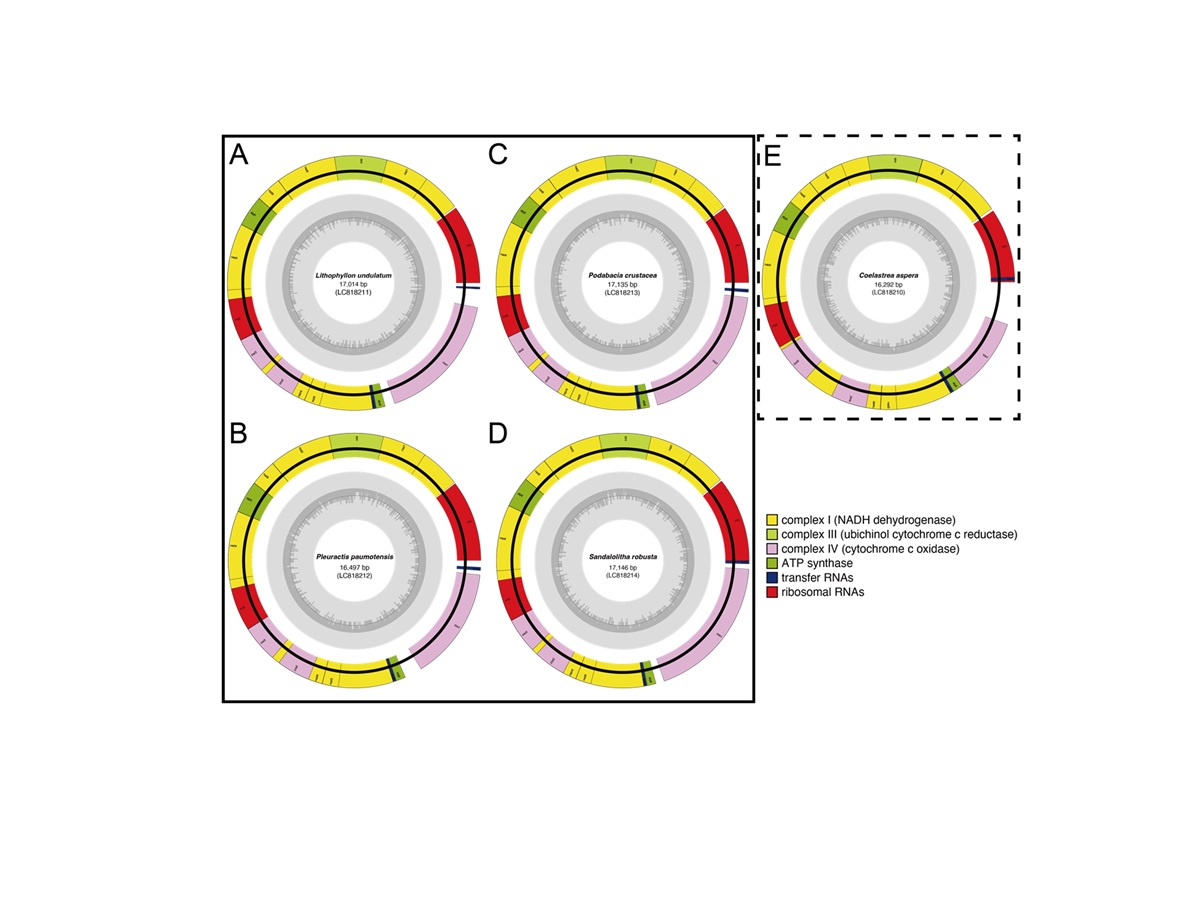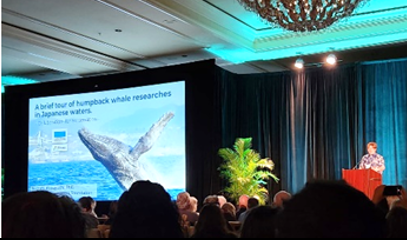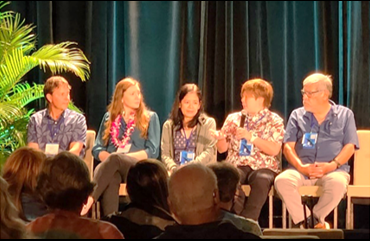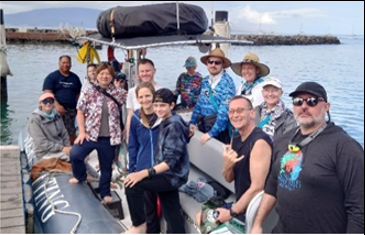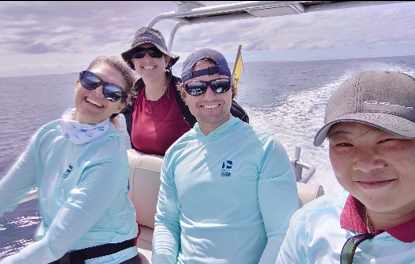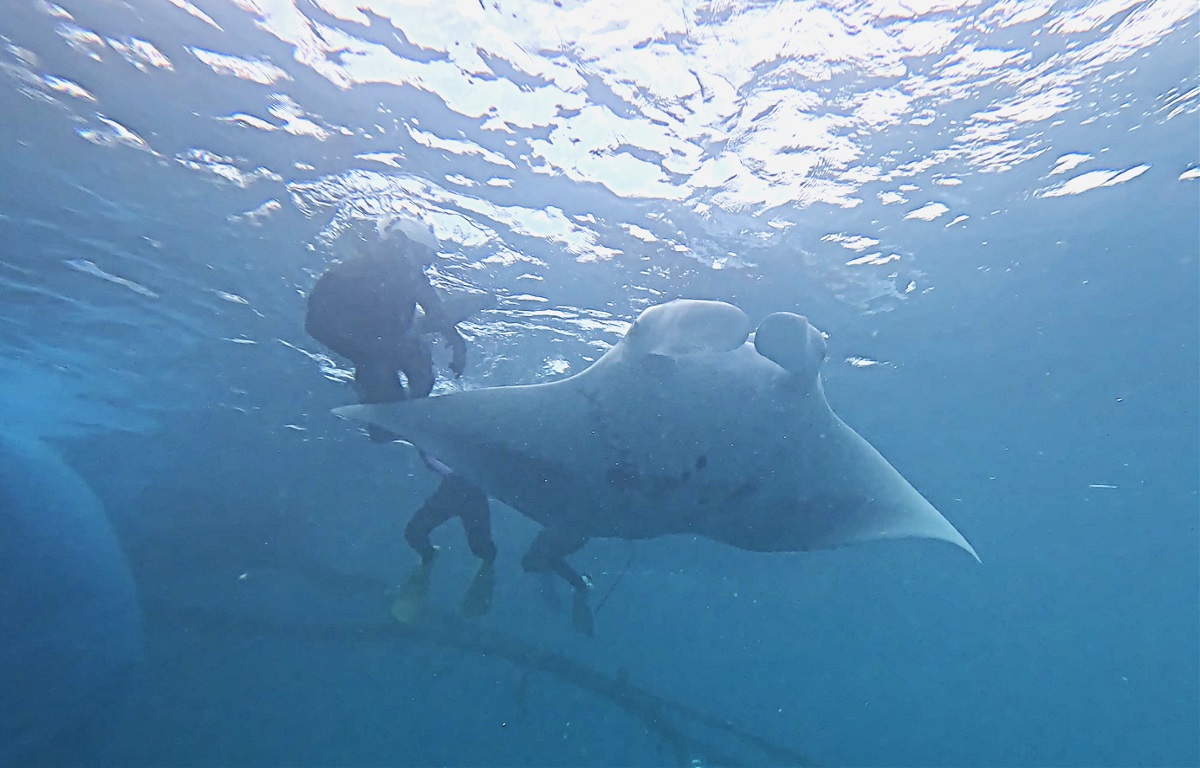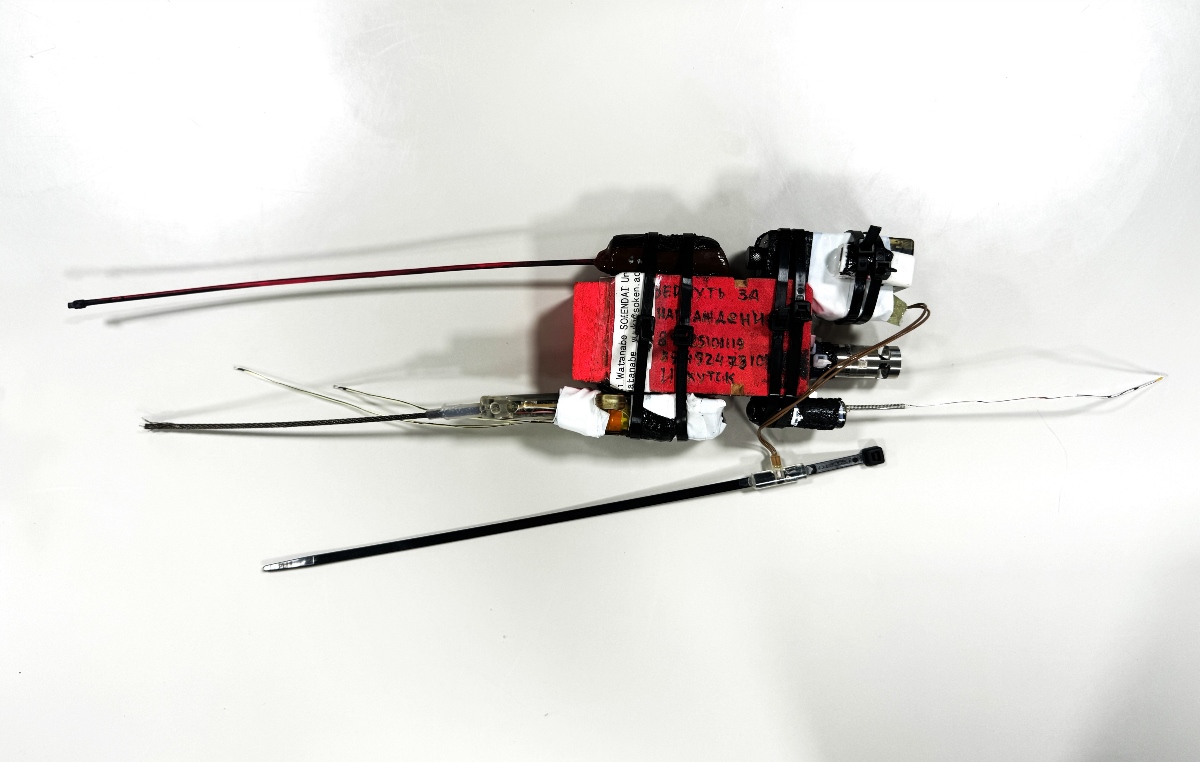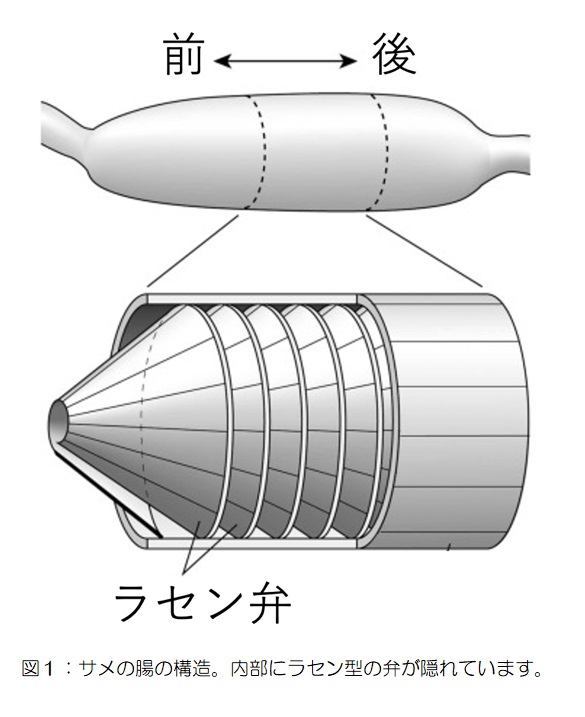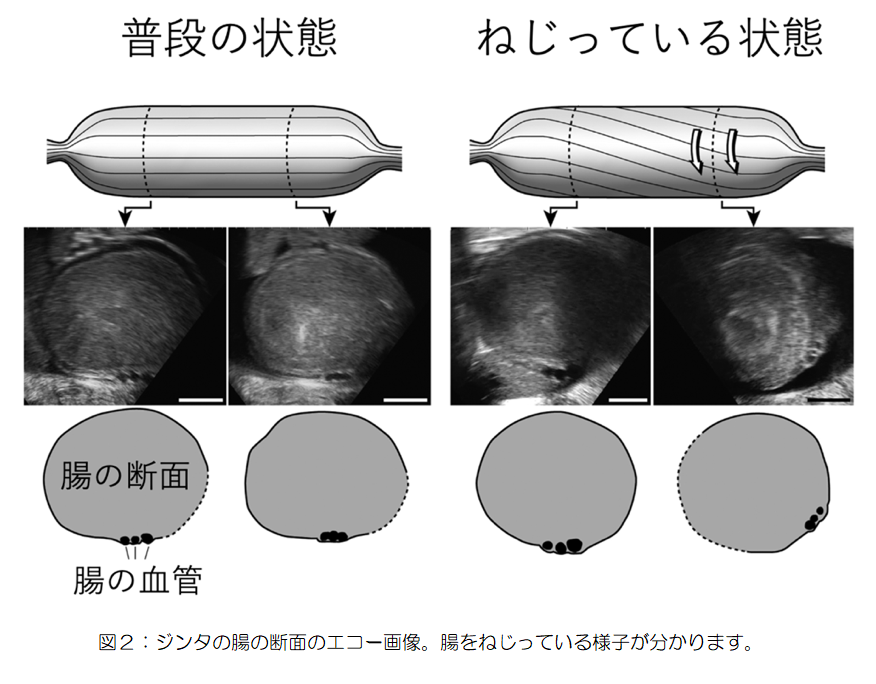Research publication and activity
Okinawa Churaumi Aquarium researches the diversity of tropical and subtropical marine life found in and around Okinawa. By researching and better understanding their physiology and ecology, we contribute to the conservation and the sustainable use of the natural environment.
2025
Research on monitoring false killer whale’s semen quality and testosterone concentration was published in the journal Mammal Study.
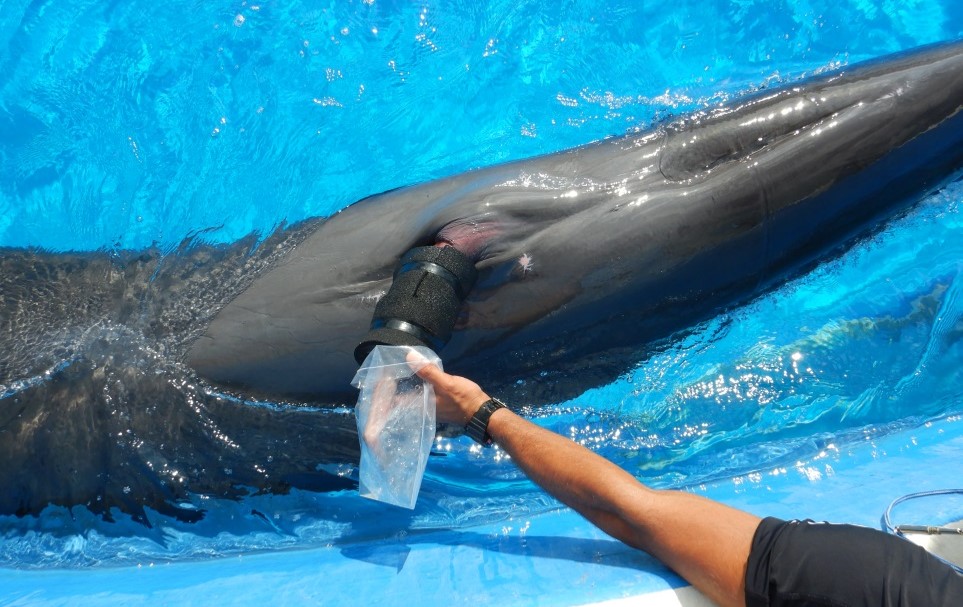
2025/Dec/13
False killer whales (Pseudorca crassidens) are cetaceans living in temperate to tropical seas. In recent years, in some areas, local populations have decreased in number. False killer whales have been classified as Near Threatened by the International Union for Conservation of Nature (IUCN).
In this study, a male false killer whale, reared long-term in our facility, was tested for seasonal changes in semen quality (semen concentration, motility, survival rate) and blood serum testosterone concentration. The results showed that as the number of ejaculations increases, the semen quality improves. The semen, especially from the fourth or fifth ejaculation, was of the highest quality, and suitable for artificial insemination. Furthermore, changes in semen quality and testosterone concentration suggest that improvement in semen quality may occur when testosterone concentration reaches its peak.
Results from this study provide new information for artificial insemination in false killer whales. This can contribute to the further development of captive breeding techniques, and to the preservation of this species. The Okinawa Churashima Foundation, which manages Okinawa Churaumi Aquarium, will continue to study cetacean reproduction and strive to establish reproductive techniques and conservation through captive rearing.
【Authors】Suguru Higa, Mariko Omata, Misato Nakamura, Nozomi Kobayashi, Keiichi Ueda, Isao Kawazu(All members are of the foundation)
【Title】Long-term monitoring of semen quality and serum testosterone concentration in a male false killer whale in managed care
【Journal】Mammal Study
【Link】https://doi.org/10.3106/ms2022-0004
Accurate measurement of whale shark length using multi-camera imaging!
2025/12/7
It is not practical to stop the movement of a large marine animal like a whale shark, and it is important to take measurements without touching their body. However, it is difficult to measure body length accurately while an animal is swimming.
In this study, we used several imaging devices together to estimate three-dimensional coordinates using a system called multi-stereo-image measurement. A whale shark being reared at the Kagoshima City Aquarium (fork length 379 cm) was measured to assess how accurately body length can be measured during swimming.
An analysis comparing configurations with two, three, and four cameras showed that, while the two-camera configuration had a large variation in estimated values, averaging 437 cm (±46 cm), the three-camera configuration averaged 402 cm (±17 cm), and the four-camera configuration averaged 411 cm (±18 cm). These results demonstrate that configurations with three or more cameras significantly reduce error. Additionally, although error increased with distance from the cameras, this increase was minimized in the three- and four-camera configurations. This shows that measurements can be taken with greater accuracy, even at distant positions.
Okinawa Churaumi Aquarium is currently advancing this technology with further technological development. The technology is expected to aid in monitoring the growth and health of species such as whale sharks, that are difficult to measure.

【Authors】Hiroto Yamamoto , Akira Sasaki , Tomoki Kanna , Yasushi Mitsunaga and Shinsuke Torisawa (Bold names indicate foundation-affiliated researchers)
【Title】Estimating Whale Shark, Rhincodon typus, Length Using Multi-Stereo-Image Measurement
【Journal】Fishes
【Link】 https://doi.org/10.3390/fishes10100513
Scientific paper published on initial food for juvenile loggerhead sea turtles
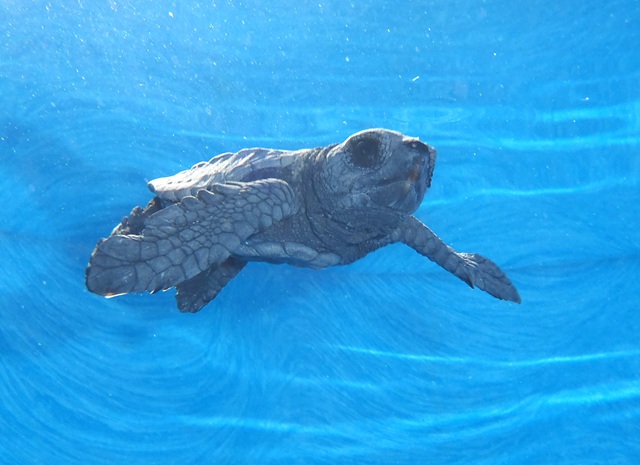
Newly hatched loggerhead sea turtle
2025/Nov/19
This study examined the effects of multiple diets on reducing mortality and preventing opportunistic infections, including fungal skin infections, in juvenile loggerhead sea turtles (Caretta caretta) that hatched less than a year before. The results showed that the turtles fed a 1:4 mixture of softshell turtle feed and mashed mince (a blend of Blue mackerel and spear squid in a 1:1 ratio) had reduced mortality and fewer fungal infections. Improved palatability of the diet, and higher growth rates were also confirmed. Nutritional analysis showed the feed is rich in calcium, iron, zinc, manganese, vitamin B2, vitamin D3, and vitamin E, all essential for growth and immune functions. The results of the research are expected to further improve the husbandry and health management of juvenile loggerhead sea turtles.
【Authors】Konomi Maeda , Masakatsu Kino , Takahide Sasai , Isao Kawazu
(All authors are members are of the Okinawa Churaumi Aquarium)
【Title】Examination of Initial Food for Juvenile Loggerhead Sea Turtles
【Journal】Zoo and Aquariums Journal Volume 67, Issue 2
Publication of scientific paper on the daytime exhibition of coral spawning

Staghorn coral spawning during the day
2025/Nov/13
In 2020, Okinawa Churaumi Aquarium developed a technique to shift the spawning hours of aquarium corals by adjusting tank lighting. The following year, they were able to exhibit corals spawning during daylight hours. In 2024, the corals that had been born in the tank during the day became sexually mature, and also successfully spawned during the day. These achievements will help shed light on coral spawning ecology, and minimize the impact of ecological exhibits on the natural environment.
【Authors】Authors:Fumihiko Nagata, Syouhei Matsuzaki, Rui Matsumoto
(All authors are members are of the Churashima Foundation)
【Title】
Adjusting spawning timing for spawning exhibition of staghorn coral in response to light and dark treatments.
【Journal】Zoo and Aquariums Journal Volume 66, Issue 4
Scientific paper published on the speciation of Hydrophis sea snakes (Elapidae) in the journal Ecology and Evolution

Hydrophis stokesii found off of Okinawa Main Island in 2021
2025/Aug/17
The speciation mechanisms of organisms have been a mystery, particularly when, geographically, there are fewer barriers in the open seas. In this study, we conducted genome-wide analyses on 16 individuals (14 species) from the highly diverse sea snake genus Hydrophis, to study the process of their evolution and speciation.
The results showed that most Hydrophis sea snakes speciated simultaneously around one million years ago. After speciation, there was little hybridization between different species, and reproductive isolation.
The species Hydrophis stokesii was found for the first time in Japanese waters off of Okinawa Main Island in 2021. Okinawan specimens had a lot less genetic diversity than specimens of the same species in Australian waters. It suggests the possibility that it may belong to a new and extremely small group.
This study was conducted in collaboration with a research team led by Professor Takushi Kishida, College of Bioresource Sciences, Nihon University.
For more information, please read the scientific paper below.
Authors: Takushi Kishida, Rina Keboushi, Takahide Sasai, Mamoru Toda Bold letters : Foundation staff
GenPaper title: Genomics Reveals Recent Rapid Speciation of Sea Snakes of the Genus Hydrophis (Reptilia, Squamata, Elapidae)
Journal: Ecology and Evolution Link to Scientific
Paper: https://doi.org/10.1002/ece3.71627
Assessing the Impact of Tidal Changes on Environmental DNA Metabarcoding
2025/Aug/11
In recent years, environmental DNA (eDNA) metabarcoding has attracted attention as a method for assessing biodiversity. Aquatic organisms release trace amounts of DNA into the environment through excretion, mucus, and skin fragments. By extracting and analyzing this DNA from water samples, researchers can identify the species present in a given area. A key feature of eDNA metabarcoding is its ability to amplify specific DNA regions and analyze them using next-generation sequencing, enabling the comprehensive detection of numerous species in a short time. Compared to traditional survey methods such as diving or capture surveys, this approach is non-invasive and highly efficient, making it widely applicable to marine ecosystem research and biodiversity monitoring.
However, in coastal areas, water flow constantly changes due to tidal movements, and how this affects the distribution of eDNA and influences survey results has not been fully understood. Since tidal fluctuations may cause the dilution or dispersion of DNA, it is crucial to determine the extent to which this impacts the accurate detection of fish communities. This study aimed to clarify these effects.
To investigate this, we collected water samples at different tidal stages in two regions of Japan with distinct climatic conditions: the Boso Peninsula in Chiba Prefecture (temperate zone) and the Motobu Peninsula in Okinawa Prefecture (tropical zone). We then conducted DNA analysis to quantitatively evaluate the impact of tidal changes on fish eDNA samples. Our findings revealed that while tidal effects were observed to some extent, their influence was relatively limited compared to other factors. These results suggest that, in many cases, tidal conditions do not need to be excessively considered when conducting eDNA-based fish community surveys.
This study contributes to the further refinement of eDNA-based survey methods and the realization of more accurate biodiversity monitoring. Future research should focus on understanding the dynamics of eDNA under different environmental conditions and optimizing survey designs accordingly.
【Authors】 Shin-ichiro Oka, Masaki Miya, Tetsuya Sado, Masayuki Ushio(Bold names indicate foundation-affiliated researchers)
【Title】Assessing the impact of tidal changes on fish environmental DNA metabarcoding in temperate and tropical coastal regions of Japan
【Journal】Metabarcoding and Metagenomics
【Link(Available for free)】 https://doi.org/10.3897/mbmg.8.135461
The 8th Okinawa Fish Seminar was held!
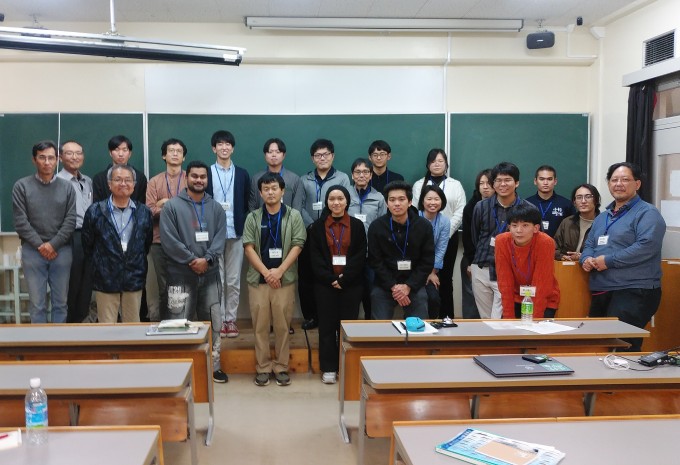
Seminar members

Research presentation
2025/Aug/11
The 8th Okinawa Fish Seminar was held at the University of the Ryukyus on March 8th, 2025. The Okinawa Fish Seminar is an annual event where researchers and students engaged in fish research in the Ryukyu Islands present their latest research and exchange information.
This year, around 30 participants from Okinawa Prefecture and Kagoshima Prefecture gathered to present their research on taxonomic and ecological studies, primarily focusing on fish species that inhabit the waters of the Ryukyu Islands. This event has provided a significant opportunity for the exchange of ideas, which may lead to advancements in fish research in the Ryukyu Islands.
Jellyfish species recorded for the first time in Japanese waters,and given Japanese name chirimen kurage.
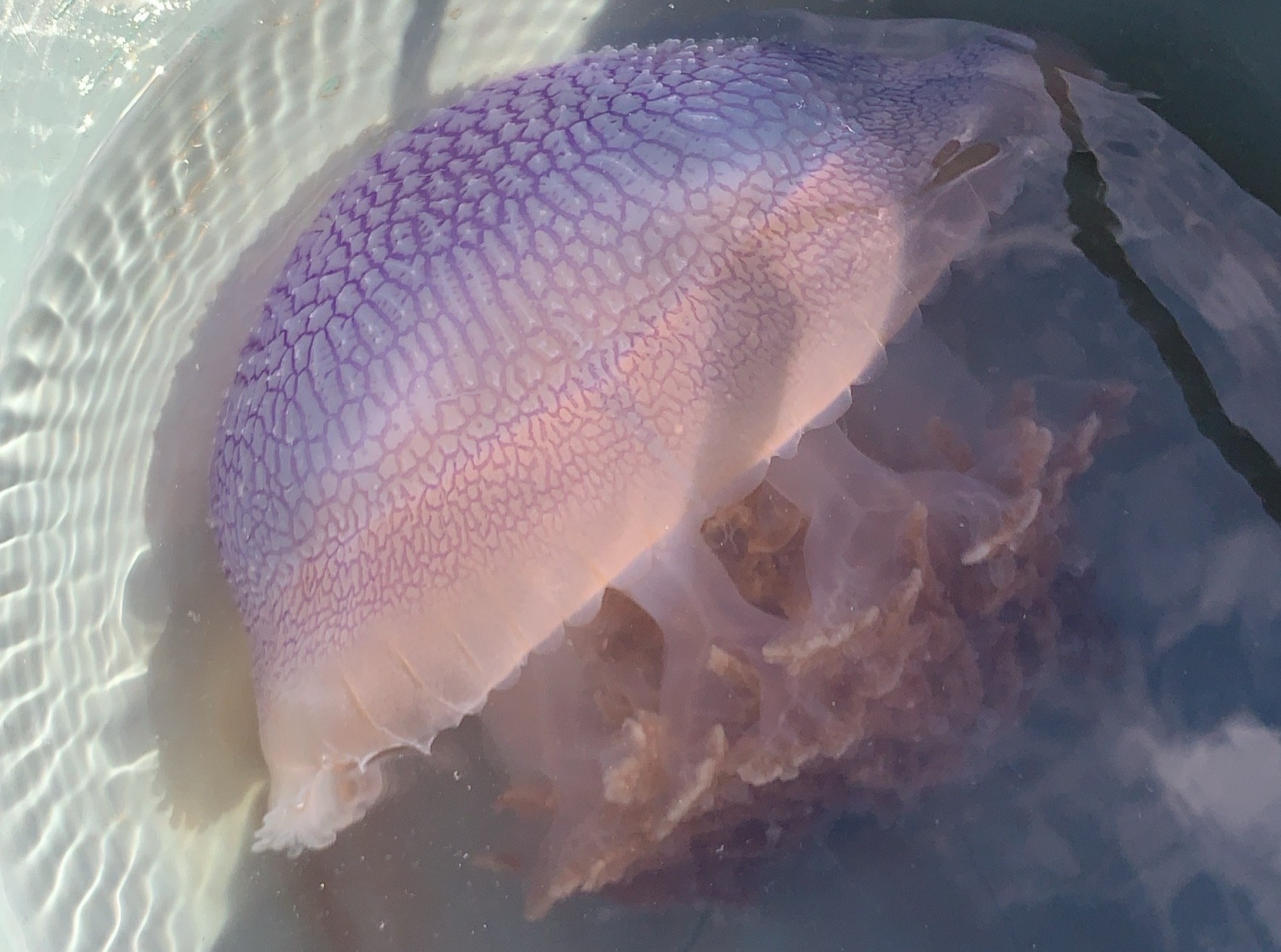
Versuriga anadyomene
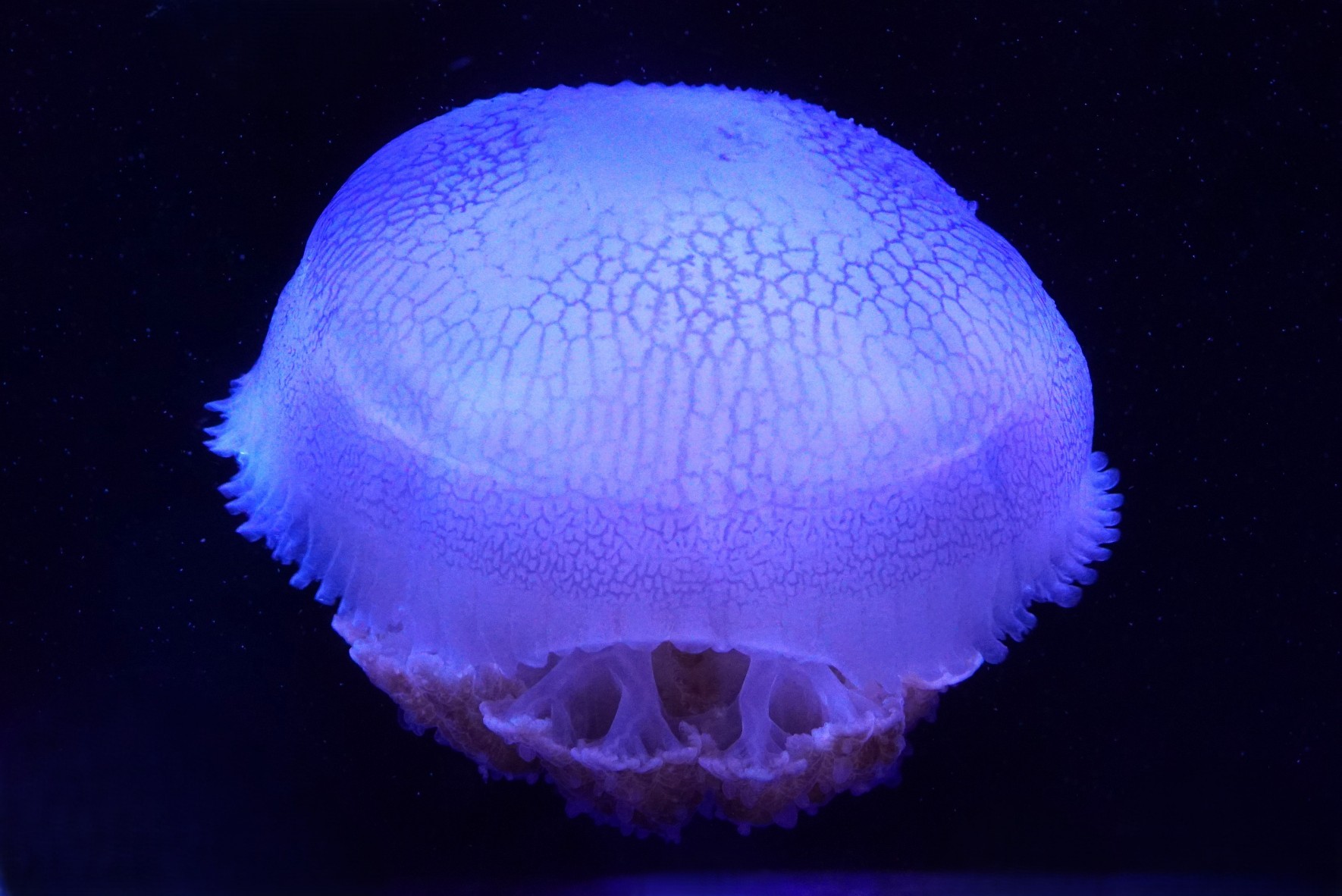
Versuriga anadyomene (Inside the tank)
2025/Jul/29
In 2022, a jellyfish specimen was collected off the coast of Yomitan. It was identified as a species of true jellyfish called Versuriga anadyomene. This was the first time it had been recorded in Japanese waters. This species has a beautiful color with distinctive mesh patterns on the surface of its bell. These patterns are similar to a traditional Japanese textile called chirimen. Its Japanese name was proposed as chirimen kurage, meaning chirimen jellyfish. Versuriga anadyomene had been reported in Southeast Asia, Australia, and Palau, and has now been recorded in Okinawan waters. Versuriga anadyomene is the only species in its genus, and Versugia is the only genus in the family Versurigidae. The species Versuriga anadyomene, the genus, and the family are therefore all given the Japanese name chirimen kurage. This study was a collaboration between Okinawa Churaumi Aquarium and the Kuroshio Biological Research Institute.
【Authors】Sho Toshino, Miyako Tanimoto
【Title】First Japanese record of Versuriga anadyomene (Scyphozoa: Rhizostomeae) from the Ryukyu Archipelago
【Journal】Biogeography
【Link】 https://doi.org/10.11358/biogeo.27.86
Almost all Japanese reef-building corals can now be detected in a single glass of seawater!
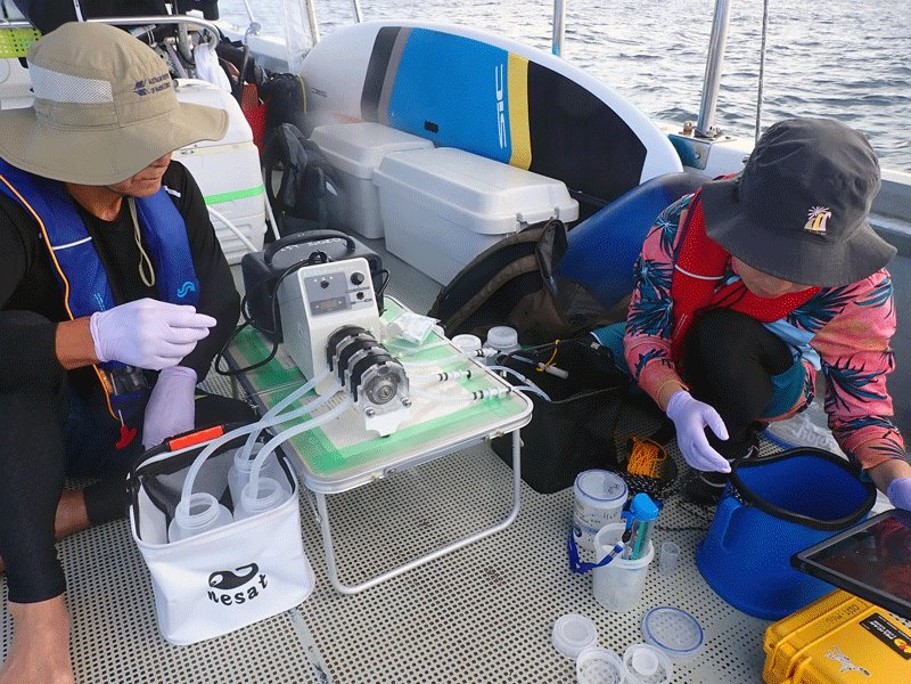

2025/Jun/17
Reef-building corals are vulnerable due to climate change and human activities. An accurate assessment of their status in each region is needed for future conservation. Until now, coral research required specialist divers and underwater imaging techniques, however, the effectiveness of this approach was limited in terms of efficiency and scope. Environmental DNA metabarcoding (eDNA-M) is an effective method to detect existing corals, but requires optimized primers for PCR amplification of eDNA, and then comparison to libraries with complete mitochondrial genome sequences. There are 85 genera of reef-building corals known in Japan, only 60 of which had been sequenced. Of the remaining 25 coral genera, the mitochondrial DNA of 22 have now been sequenced, and an additional 12 genera were re-sequenced. Okinawa Churashima Foundation has contributed by creating the genome sequence data of 7 genera. By integrating this new data, future studies of eDNA-M will now be able to detect 83 of 85 known genera. This allows for comprehensive genus-level detection of nearly all Japanese reef-building corals in a single glass of seawater. This research was conducted in cooperation with a research team led by Professor Noriyuki Satoh of the Marine Genomics Unit at the Okinawa Institute of Science and Technology (OIST).
Authors name:
Kanako Hisata, Tomofumi Nagata, Megumi Kanai, Frederic Sinniger, Fumihiko Nagata,
Mayuki Suwa1,Yuki Yoshioka1, Saki Harii, Masanori Nonaka, Hironobu Fukami, Seiji Arakaki,
Manabu Fujie, Nana Arakaki, Yuna Zayasu1, Haruhi Narisoko, Takeshi Noda1, Aya Koseki,
Koki Nishitsuji1, Jun Inoue, Chuya Shinzato, and Noriyuki Satoh
Paper Title:
An eDNA metabarcoding system for detecting scleractinian corals to the generic level along the Japanese coast
Journal Name: Galaxea, Journal of Coral Reef Studies
Link: https://www.oist.jp/ja/news-center/news/2025/5/22/discovering-rich-biodiversity-coral-reefs-using-comprehensive-new-system
A scientific paper written by members of Okinawa Churaumi Aquarium was awarded the 2025 technical award by the Japanese Association of Zoos and Aquariums.
2025/Jun/10
sea anemone, live in symbiosis with anemonefish species. Both are highly popular for ornamental aquaria, and their capture is a cause of decreases in wild populations. In the 1970s and 1980s, captive breeding techniques for anemonefish developed. However, captive breeding of the host sea anemones has been limited, and knowledge of their reproduction was also limited.
From 2019 to 2022, Okinawa Churaumi Aquarium conducted research to shed light on the reproductive ecology of gigantic sea anemones, and to develop captive reproduction with the aim of conservation. Using a puncture needle to distinguish sex, mixed genders of anemones were kept in outdoor tanks. We succeeded in capturing footage of reproductive behaviors and collected fertilized eggs. Breeding of the gigantic sea anemone took place between June and July (in water temperatures from 26.1 to 27.2 ℃). Six to nine days after a full moon, sperm were released one hour before sunset, and egg spawning began after sunset.
In 2023, the same methods were used for the successful captive breeding of the leathery sea anemone, and in 2024, for the successful captive breeding of the Merten's sea anemone. The techniques are expected to contribute to the ex situ conservation of numerous host sea anemone species.
【Award recipients】 Shohei matsuzaki, Mayu suzumura, Miyako Tanimoto, Mariko Omata, Eeri Nakashima, Kiyomi Murakumo (Okinawa Churaumi Aquarium)
【title】Original Research Paper: Method of Sex Identification and Captive Breeding of the Gigantic Sea Anemone
【Journal publishing article】Journal of the Japanese Association of Zoos and Aquariums, Vol. 66, No. 3, 57–66, 2024.
Publication of a scientific paper on black sea turtles ingesting marine debris in the waters around Okinawa Main Island!
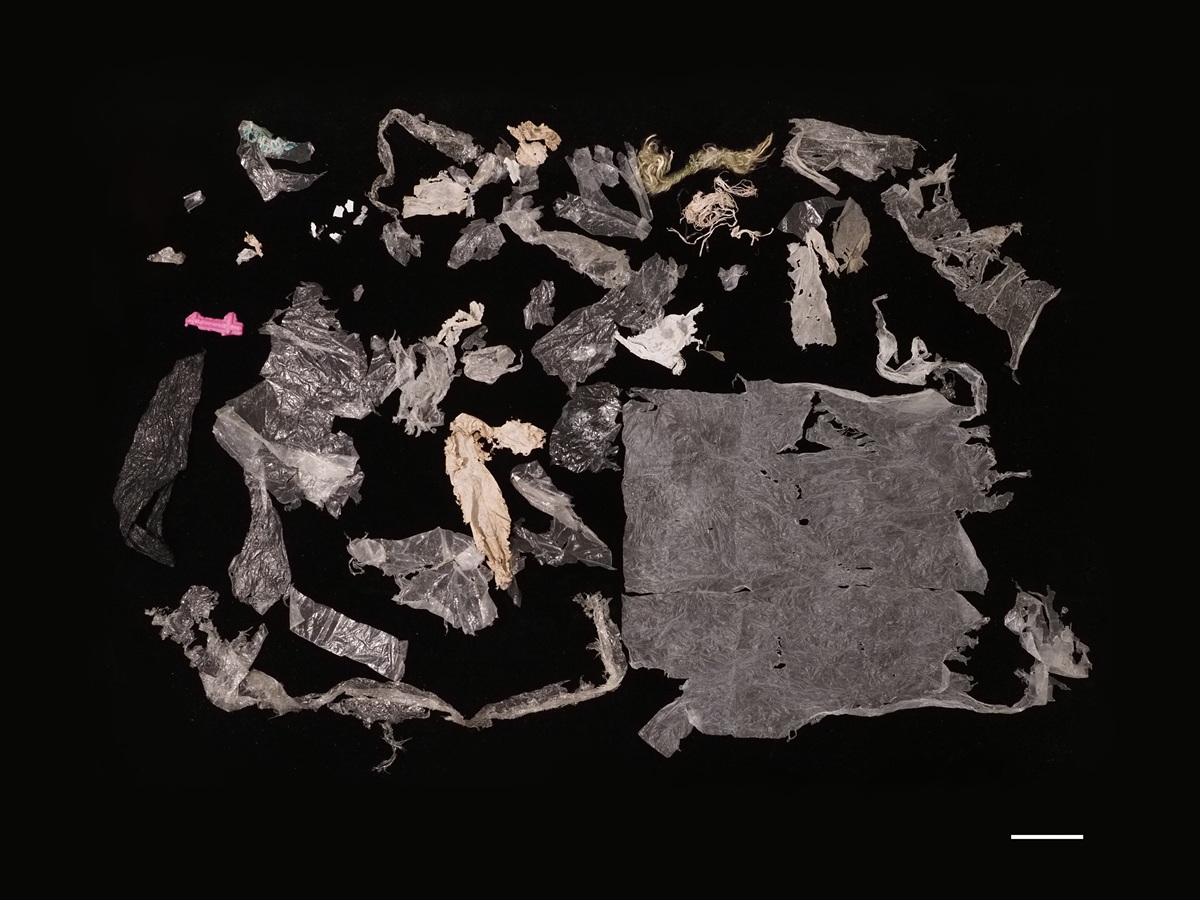
Artificial substances excreted from a black sea turtle
(Length of scale line is 50 mm)
2025/May/17
Man-made marine debris affects many marine animals, and has become a global problem. Man-made objects, when ingested by sea turtles, negatively impact their growth and survival. An understanding of the extent of this problem is important for sea turtle conservation around Okinawa Main Island.
From 1999 to 2023, we conducted the first quantitative survey of ingested marine debris in the Western Pacific, with the study of five black sea turtles. Three black sea turtles were found alive, cared for at Okinawa Churaumi Aquarium, and they excreted soft plastics and other artificial materials over 2 to 72 days. The other two black sea turtles were found deceased and washed ashore. Necropsies showed that one of these turtles had artificial objects in their digestive tract.
Of this sample, four of the five turtles (80%) had consumed man-made marine debris. This is a higher percentage than seen in other species of sea turtles inhabiting the same area. A higher rate of marine debris consumption, especially if caught in their digestive tracts, will cause a deterioration in health of the black sea turtle population. The researchers suggest that black sea turtles, when found in distress near Okinawa Main Island, should undergo emergency rescue to quickly remove artificial objects using medication and endoscopy.
For more information, please read the scientific paper below.
Authors:Takahide Sasai・Kei Yamazaki・Ken Maeda・Kaho Mizuochi・Masakatsu Kino・Isao Kawazu
Paper Title:Marine debris ingestion of black sea turtles Chelonia agassizii around Okinawajima Island, Japan
Journal Name:Umigame Newsletter of Japan
For further details, please see the paper here
Publication of a scientific paper on whale shark behavior
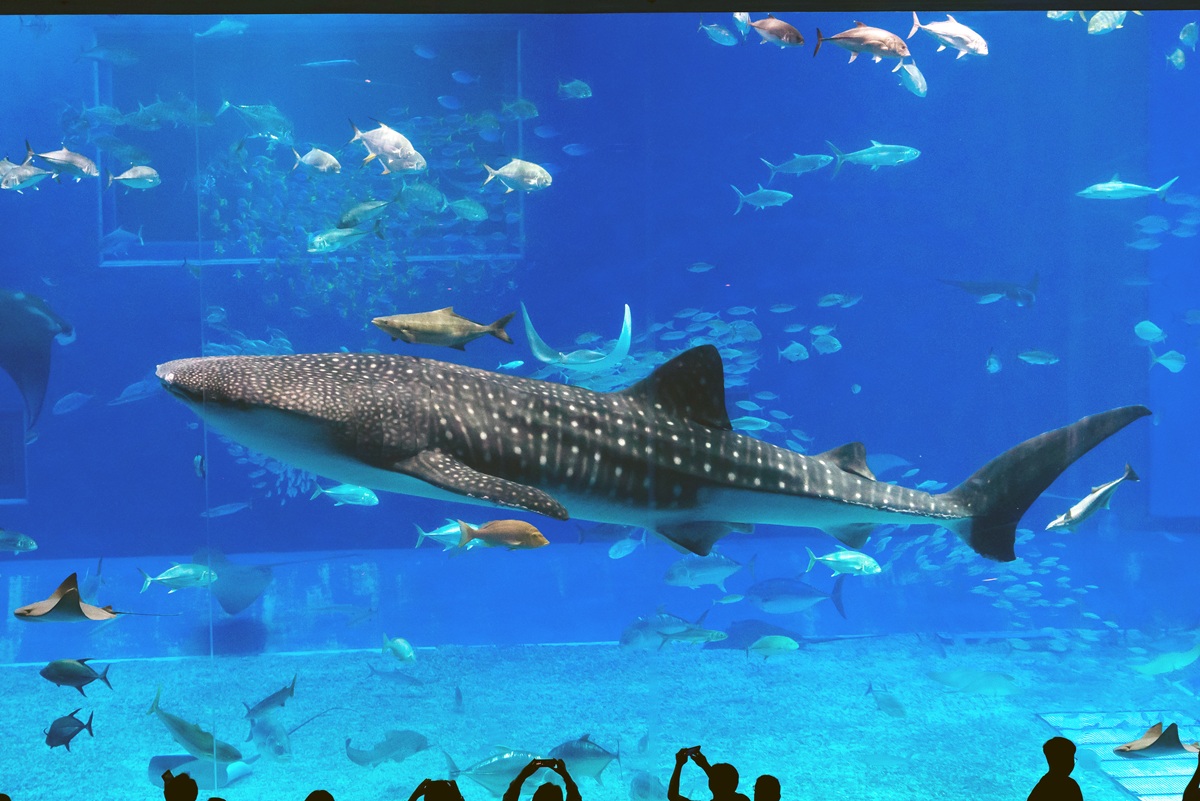
whale sharks (Rhincodon typus)
2025/Apr/5
It takes many years for whale sharks (Rhincodon typus) to reach maturity, and long-term observation is necessary to study their reproduction and conservation. For this reason, understanding how environmental factors impact behavior is important for conducting appropriate rearing. In this study, we attached a data logger to a male whale shark that has been reared at Okinawa Churaumi Aquarium for over 29 years. We wanted to see how water temperatures and light might influence its swimming behavior.
The data logger showed the whale shark’s tail beat frequency, swimming speed, and level of activity, decreased between 4% to 20% when comparing day and night in all seasons. Its activity decreased by as much as 20% on nights when water temperatures were lower than 23.6℃. In addition, approximately 90% of “clasper crosses” (movement of male genitalia), a reproductive behavior of male sharks, occurred during daytime.
These results indicate that the current rearing environment is appropriate for the whale sharks, as it has a diurnal rhythm with higher activity during the day, while at night it beats its tail more slowly to conserve energy. The results of this research will deepen our understanding of the behavioral characteristics of whale sharks, and will be useful in future rearing management and conservation activities.
【Authors】
Tomoki Kanna, Sayaka Takahashi, Eundeok Byun , Atsushi Yamashiro , Rui Matsumoto , Shinsuke Torisawa , Yasushi Mitsunaga (太字:財団職員)
【Title】
Seasonal behavioral changes of a captive whale shark (Rhincodon typus) under variable temperature and light conditions
【Journal】 Fishery Bulletin
Rearing research on serum selenium concentration in hawksbill sea turtles was published in the journal Current Herpetology!

hawksbill sea turtles (Eretmochelys imbricata)
Selenium is a trace element that exists naturally in marine environments. In oviparous (egg-laying) animals, when the concentration of selenium is low within the blood, there is a risk of hatching rates dropping. In this study, the serum selenium concentration of 45 wild and captive endangered hawksbill sea turtles (Eretmochelys imbricata) were compared, and changes in serum selenium concentration were monitored during the captive period. The results showed that the serum selenium concentration is significantly higher in wild hawksbill sea turtles than captive hawksbill sea turtles. The decline was particularly noticeable after one to two years in captivity. This result suggests that this may lead to lower rates of hatching in captivity.
The Okinawa Churashima Foundation that manages Okinawa Churaumi Aquarium will continue to promote conservation research and will work toward finding a solution to this challenge.
【Authors】
Kino Masakatsu, Isao Kawazu, Konomi Maeda
(All authors are staff of the Churashima Foundation)
【Title】
Relationship between Serum Selenium Concentration and Rearing Period in Hawksbill Turtles
【Journal】 Current Herpetology
Scientific paper published on the classification review of a parasitic trematode in the lungs of the Chinese Sea Snake
Pulmovermis cyanovitellosus is a parasitic trematode found in the lungs of the Chinese sea snake. It was discovered in Taiwan in 1960, and later recorded in Japan and Korea. The unusual trait of living in the lungs of sea snakes led to its classification in a new genus, Pulmovermis. Recent molecular phylogenetic studies and morphological studies based on genetic sequences have revealed that these parasites should be reclassified as members of the preexisting genus Lecithochirium. With this discovery, it was proposed that this species be reclassified with its new genus, and referred to by the scientific name Lecithochirium cyanovitellosum.
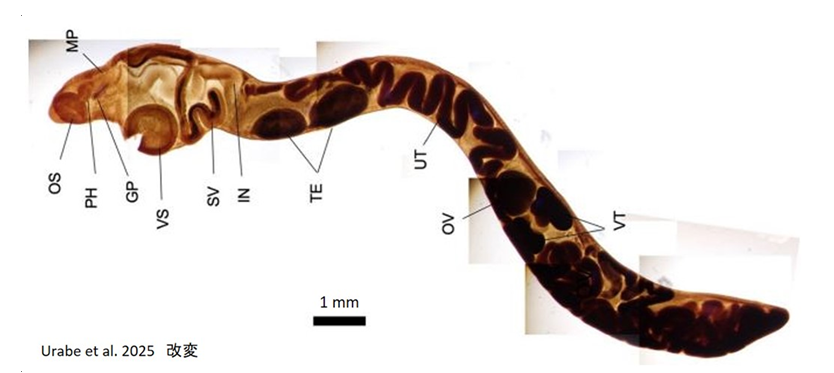
Lecithochirium cyanovitellosum body (Left image)
Authors name:
Misako Urabe, Takahide Sasai, Sergey G. Sokolov
Paper Title:
Rejection of the concept of hemiurid genus Pulmovermis (Digenea: Hemiuridae) and other taxonomic propositions: new morphological and molecular data regarding Lecithochirium cyanovitellosum (Coil and Kuntz, 1960) Urabe and Sokolov, comb. nov. (formerly Pulmovermis cyanovitellosus)
Journal Name: Systematic Parasitology
Link: 10.1007/s11230-025-10213-3
2024
Evolutionary secrets revealed through a complete analysis of the mitochondrial genome of the family Fungiidae
Fungiidae is a family of reef-building corals commonly known as mushroom corals. Their mushroom-like shapes, and free-living colonies, are widely recognized, but their mitochondrial genetic information had not been fully sequenced.
In this study of aquarium specimens, four species in the family Fungiidae (Lithophyllon undulatum, Pleuractis paumotensis, Podabacia crustacea, Sandalolitha robusta) and one species in the family Merulinidae (Coelastrea aspera) had their entire mitochondrial genetic information sequenced.
These results showed that the four Fungiidae species and the one Merulinidae species had the same mitochondrial genetic set as in other reef-building corals, and the phylogenetic relationships inferred from the whole mitochondrial genome were identical to those from previous studies using partial genetic information. The accurate and complete mitochondrial genetic sequences will be useful for understanding the ecology and evolution of corals in the future. This study was conducted in collaboration with a research team led by Professor Noriyuki Satoh from the Marine Genomics Unit at the Okinawa Institute of Science and Technology (OIST).
Authors name:
Yuki Yoshioka, Fumihiko Nagata, Masanori Nonaka, and Noriyuki Satoh
Paper Title:
Molecular phylogenetic position of the family Fungiidae (Cnidaria: Anthozoa) based on complete mitochondrial genome sequences
Journal Name: Galaxea, Journal of Coral Reef Studies
Link: https://www.jstage.jst.go.jp/browse/galaxea/26/1/_contents/-char/en
Scientific paper published on the population status of three endangered species of lizards inhabiting Shimoji Island and Irabu Island!
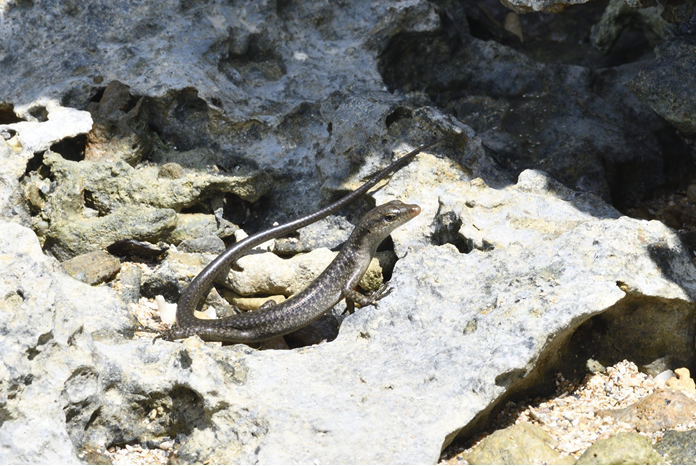
Target species of the survey, the littoral whiptail-skink

Miyako grass lizards
The Japanese weasel (Mustela itatsi) was introduced to the Ryukyu Islands, and has had a negative impact on native terrestrial vertebrates. Researchers evaluated the population status of three species of lizards living on Shimoji Island and Irabu Island. These three endangered lizards are the Kishinoue's giant skink (Plestiodon kishinouyei), the Miyako grass lizard (Takydromus toyamai), and the littoral whiptail-skink (Emoia atrocostata). Route censuses for the three species took place in 2022 from July 30th to August 4th and October 8th to October 13th at various locations on both islands.
We recorded the Kishinoue’s giant skink in only 4 of 101 survey routes, the Miyako grass lizard in only 6 of 76 survey routes, and the littoral whiptail-skink in only 2 of 39 survey routes.
The Kishinoue’s giant lizard and the littoral whiptail-skink show a very limited distribution with the former found only in the northwestern part of Shimoji Island, and the latter found only in the southwestern part. Neither species was found on Irabu Island. The Miyako grass lizards were confirmed on both Shimoji Island and Irabu Island, however less frequently on Irabu Island suggesting a possible decline in population on Irabu Island.
This study provides basic data on the population status of these three species of lizard. This data will be an important resource for evaluating the recovery of lizard populations after a project to eradicate the invasive Japanese weasel has taken place.
Authors name:
Hitomi Asato, Takahide Sasai, Takumi Yamamoto, Mamoru Toda
Paper Title:
Population status of three endangered lizards on Shimojijima Island and Irabujima Island, Ryukyu Archipelago, Japan
Journal Name: Current Herpetology
Link: https://doi.org/10.5358/hsj.43.159
Collaborative research begins tracking loggerhead turtle hatchlings
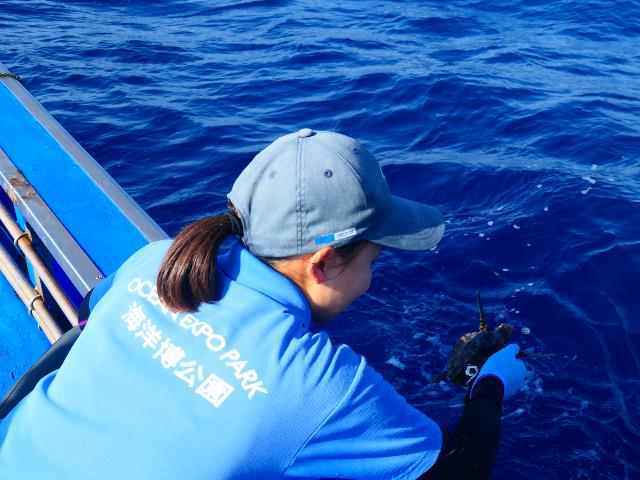
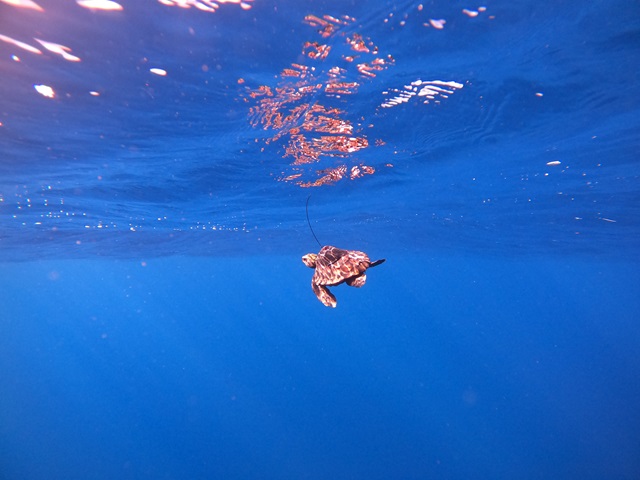
Twelve loggerhead turtles, approximately three months old, reared at Okinawa Churaumi Aquarium, were tagged and released. This study addresses one of the biggest mysteries in sea turtle research: how hatchlings migrate and develop in the ocean. Understanding the ecology of hatchlings, which face particularly low survival rates, is a crucial research project that contributes to the conservation of the endangered loggerhead turtle. The survey is a collaborative effort conducted by researchers from the Okinawa Churashima Foundation, which manages and operates Okinawa Churaumi Aquarium, the NPO Upwell, and the NPO Sea Turtle Ecology Lab. The research will continue to contribute to the conservation of endangered species through scientific studies.
Collaborating with a Hawaiian research organization to conduct research on false killer whales!
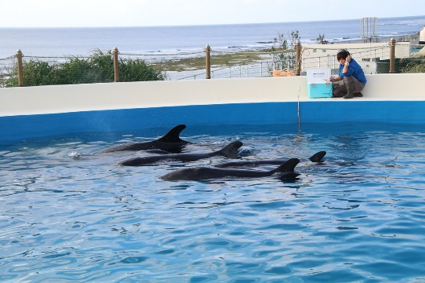
Research on a false killer whale being conducted
at Okinawa Churaumi Aquarium①
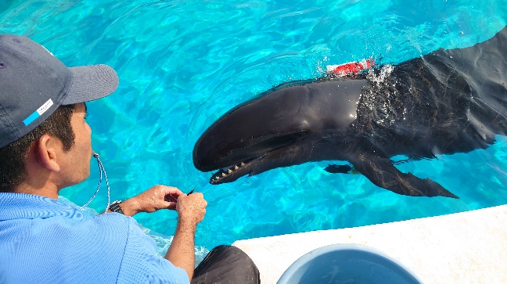
Research on a false killer whale being conducted
at Okinawa Churaumi Aquarium②
2024/Dec/2
Okinawa Churaumi Aquarium rears several species of toothed whales including false killer whales, Indo-Pacific bottlenose dolphins, and rough-toothed dolphins. Our goal is that the research we conduct in captivity gives us a better understanding of their ecology and helps conserve these species in the wild.
Currently, we are collaborating with a Hawaiian research organization to research false killer whales. In Hawaiian waters there are populations of endangered false killer whales and only 135 individuals have been confirmed. Therefore, to help conserve this population, there are new measures to prevent bycatch by fishing. Research is being conducted using drones to measure body length and width, and therefore determine their health.
Okinawa Churaumi Aquarium, cooperated with a Hawaiian false killer whale research team, by taking accurate measurements of the false killer whales that are reared here at the aquarium. We used a drone to remeasure their body length and width, and could then deduce the degree of error between the accurate measurements and the measurements made with a drone. This is necessary to correct the drone measurements taken of individuals in the wild. We have also initiated a study to measure the metabolic rate of false killer whales by the analysis of blood and respiration. By collecting data and behavioral observations of captive individuals, which would be difficult in the wild, we aim to help conserve individuals in the wild. We will continue to focus our research on captive individuals in cooperation with domestic and international researchers.
13-meter whale sharks!Participation in international joint research in the Galapagos Islands!
2024/Dec/2
Whale sharks (Rhincodon typus) are found in all the world’s oceans except the Arctic Ocean and Antarctic Ocean. When observed, their location is usually correlated with the abundance of food. However, around Darwin Island, the northernmost of the Galapagos Islands, concentrations of whale sharks are seen from June to October, and this does not correlate with increased food. The whale sharks observed in the Galapagos Islands are mostly large females over 10 meters. The presence of so many large females is unique to the Galapagos Islands. Many of these whale sharks have a large, swollen abdomen suggesting they may be pregnant. Researchers from around the world, see the Galapagos Islands as a key place to shed light on the reproductive ecology of whale sharks.
Since 2017, Okinawa Churashima Foundation, because of their scientific understanding of whale shark ecology, has collaborated with the international research organization Galapagos Whale Shark Project with the aim of species conservation. The techniques developed by our foundation during health checks such as underwater ultrasound and blood collection, assisted with better understanding the reproductive physiology of wild whale sharks. In June (2024) we encountered twelve 10- to 13-meter whale sharks. We were able to conduct ultrasounds on six individuals and collected blood samples from five individuals. The blood samples were cryopreserved, and are currently held at the Universidad San Francisco de Quito in Ecuador until permits for their export and import have been granted under CITES (Washington Convention). Analysis of the blood and hormones at our foundation’s lab, combined with the data obtained in the field from blood samples and ultrasounds will allow us to deepen our limited understanding of whale shark reproductive physiology. We continue to cooperate with this project, as well as working with domestic research facilities, to increase scientific knowledge, and contribute to the conservation of whale sharks.
Previous study: Scientific paper published on ecological study of wild whale sharks | Okinawa Churashima Foundation
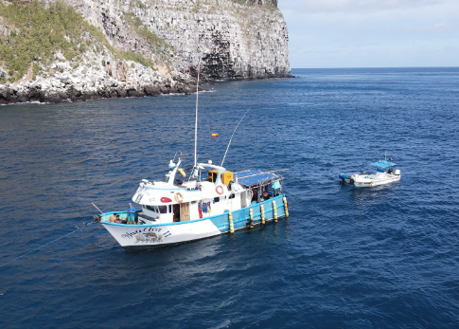
Research boat
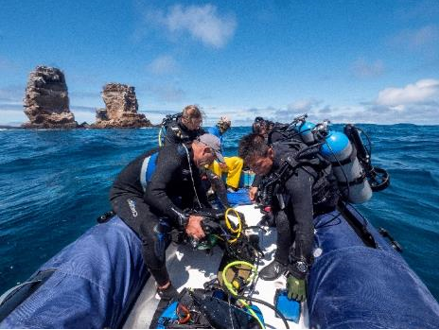
just before diving into water
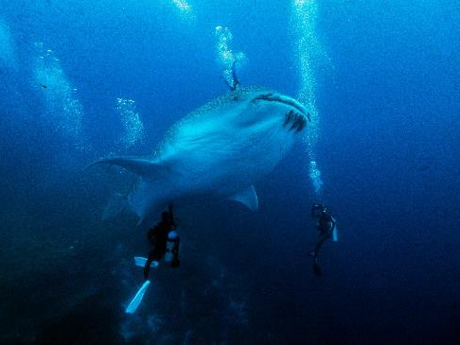
Performing an underwater ultrasound

Taking blood samples underwater
Scientific paper published on humpback whale populations in the North Pacific Ocean and the effects of climate change!
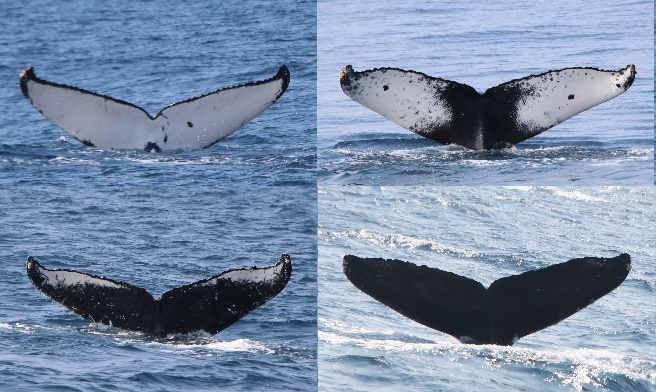
Unique humpback whale flukes
2024/Dec/2
The flukes of humpback whales have unique shapes and patterns, and these characteristics can be used to identify individuals. To estimate humpback whale populations, researchers analyzed over 190,000 images of flukes collected between 2002 to 2021 in Okinawa and other areas including Japan, Philippines, Hawaii, Mexico, America, and Russia.
The results showed that in the North Pacific Ocean from 2002 to 2012, humpback whales increased in number from approximately 16,875 individuals to 33,488 individuals. Then from 2012 to 2021, the number of humpback whales declined to 26,662 individuals. The population of humpback whales breeding around Hawaii peaked in 2013, then began gradually decreasing. By 2021 the population had decreased by nearly 34%.
The results suggest the population of humpback whales in the North Pacific Ocean reached its limit environmental carrying capacity. The strongest recorded marine heat wave that occurred between 2014 to 2016 may have had a long-term effect on humpback whale populations and their recovery. We will continue to cooperate in this research across the North Pacific Ocean to better understand the changes in humpback whale populations and the effects of climate change.
【Author】Ted Cheeseman, Jay Barlow, …, Nozomi Kobayashi, …, Haruna Okabe …, Phil Clapham (and other 69 co-authors)
【Title】Bellwethers of change: population modelling of North Pacific humpback whales from 2002 through 2021 reveals shift from recovery to climate response
【Journal】Royal Society Open Science
【Link】https://doi.org/10.1098/rsos.231462
Lecture on Japanese humpback whales and field research held in Maui, Hawaii
2024/Dec/2
Whale Tales, an educational event for sharing research on humpback whales, was held in Maui, Hawaii, U.S.A. A member of staff from the Okinawa Churashima Foundation gave a lecture on humpback whale research and initiatives conducted in Japan including Okinawa.
The 17th annual Whale Tale event was sponsored by Whale Trust, a research organization that has conducted research on cetaceans for many years in the state of Hawaii. Over 800 attendees came from Hawaii and abroad, and scientists from all over the world (Hawaii, Mexico, Philippines, Nicaragua, and Japan) were invited to present lectures on their studies of cetaceans and whale watching industries done in their countries.
A member of staff from the Okinawa Churashima Foundation joined the panel discussion, and gave a lecture on the initiatives made in Japan concerning humpback whales. As part of the event, the staff member took part in a whale watching tour as a researcher, and answered questions and provided explanations to the general public.
After the event, the staff member collaborated on research with the Keiki Kohola Project and the Pacific Whale Foundation that conducts humpback whale research in Hawaii, to deepen our ties to further conserve humpback whales throughout the North Pacific Ocean.
Giving a lecture at Whale Tales, panel discussion, and whale watching tours
Taking part in humpback whale field research
A study on the impact of commercial whale watching and swim-with-whale tours on humpback whale behavior in Okinawa was reported to the International Whaling Commission (IWC)
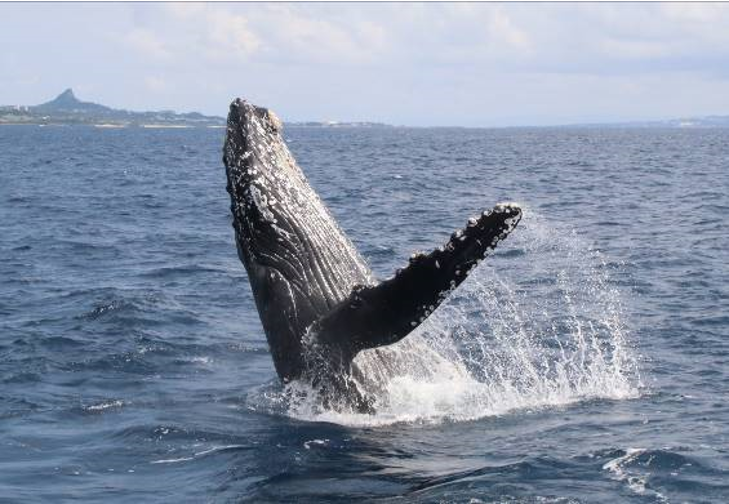
A breaching humpback whale
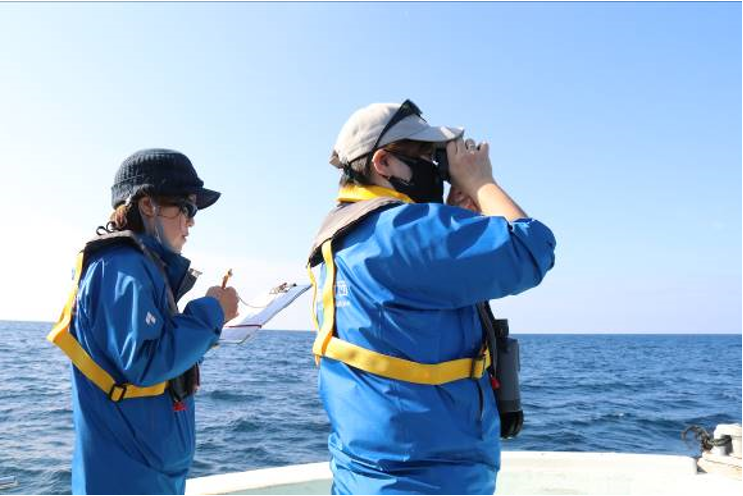
Conducting surveys
2024/Dec/2
In recent winters, whale watching and swim-with-whale tours have been popular tourist activities around the Okinawan and Amami islands. However, there are concerns about how these tours could affect the humpback whales that are being observed. In 2022, our foundation collaborated with businesses in Okinawa Prefecture and the research organization Pacific Whale Foundation (PWF) from Hawaii to launch a whale watching and swim-with-whale impact assessment study.
From studies conducted in the 2022-2023 winter, we collected data during 15 whale swim tours and 12 whale watching tours that encountered 64 groups of humpback whales. This study was reported to the IWC scientific committee sub-committee on whale watching.
As we analyze the results, we aim to help create both a better environment where humpback whales and humans can co-exist, and develop the tourism industry in Okinawa Prefecture.
【Author】
Stephanie H. Stack, Nozomi Kobayashi, Haruna Okabe, Sachie Ozawa
【Title】
Studying the behavioral impacts of commercial whale watch and swim-with-whale tours on humpback whales in Okinawa, Japan.
【Scientific Committee】
Report to the IWC Scientific Committee sub-committee on Whale Watching
Scientific paper published on the world’s first large scale dataset of humpback whale photo identification
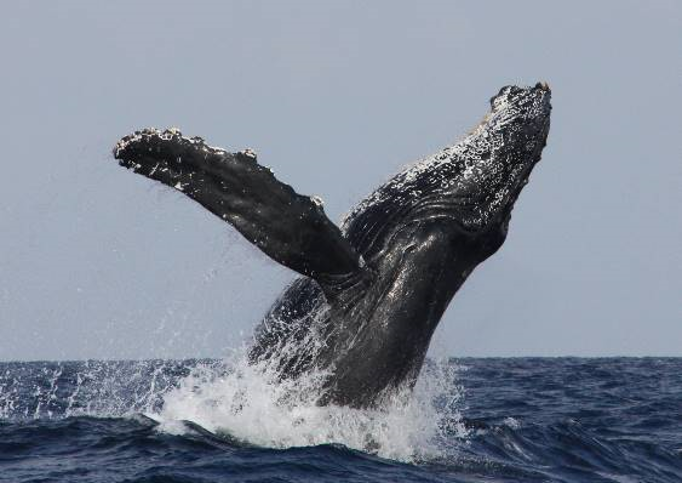
Humpback whale breaching
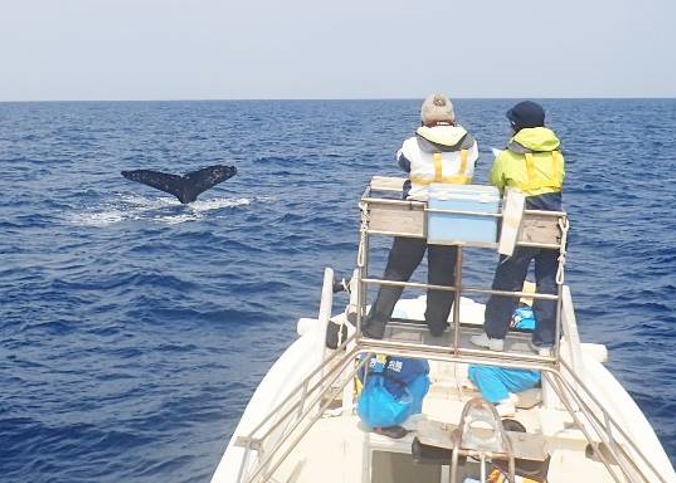
photographing flukes during a survey
2024/Dec/2
Each humpback whale has flukes with a unique pattern and shape, this allows individual humpback whales to be identified. A scientific paper was published on the creation of a dataset of humpback whale fluke images from across the entire North Pacific Ocean, and the first ever development of an AI-based fluke matching system.
The humpback whale fluke identification photographs used in this research were collected and provided by 39 research organizations, aggregated into 13 regions (6 breeding grounds, 6 feeding regions, and 1 migratory corridor). These identification photographs were matched and aggregated using an AI-based automatic image recognition system to create the world’s first large scale dataset of humpback whale identification photographs. Between 2001 and 2021, 157,350 encounters resulted in the identification of 27,956 unique individuals. Analysis of the photographs showed that 87% of the humpback whales in the North Pacific Ocean were encountered in more than one season, and the average observation count was 5.6 times.
The large-scale data set, and the AI-based automatic image recognition system that was developed in this research is an extremely important technology and information source to plan for conservation and understanding the ecology of the humpback whales that migrate great distances across regions.
【Author】
Ted Cheeseman, Ken Southerland, …, Nozomi Kobayashi, …, Haruna Okabe, …, Phil Clapham(and 64 other co-author)
【Title】
A collaborative and near‑comprehensive North Pacific humpback whale photo‑ID dataset
【Journal】
Scientific Reports
【Link】
https://rdcu.be/dVXjl
Presentations on how sea snakes find and identify prey, and age estimation of Kishinoue’s giant skink given at the 10th World Congress of Herpetology.

Giving a presentation 1

Giving a presentation 2
2024/Dec/2
From August 5th to 9th 2024, members of our staff made presentations on their research findings at the 10th World Congress of Herpetology held in Kuching, Sarawak, Malaysia. The World Congress of Herpetology is the world’s largest conference on reptiles and amphibians, and is held every four years. Around 1,400 people, from all over the world, attended and made presentations and symposiums on their specific expertise. Members from our foundation made research presentations on how captive sea snakes find and identify prey, and the conservation of lizards. We exchanged opinions with scientists from around the world to help with future research and conservation.
【Conference】 10th World Congress of Herpetology
【Title of the presentation】1.How sea snakes find and identify their prey in water(Presenter: Hidetaka Sasai, at The symposium of diversity and evolution of snake sensory systems)
2.Age Structure and Growth Pattern of the Kishinoue's Giant Skink, Plestiodon kishinouyei (Squamata: Scincidae), Inferred by Skeletochronology(Presenter: Hidetaka Sasai)
Presentation on shark conservation techniques given at international symposium
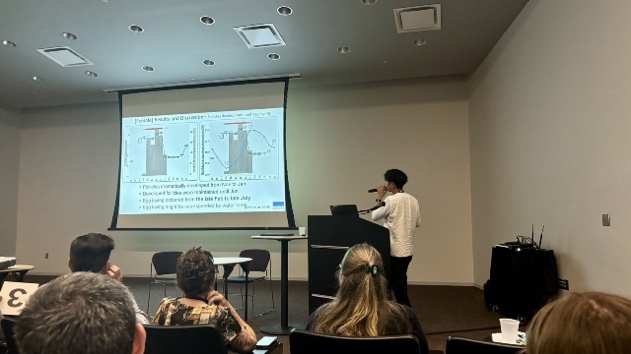
Presentation at the symposium(Okamoto)

Presentation at the symposium(Tomita)
2024/Dec/2
On July 10th, 2024, members of staff from the Okinawa Churashima Foundation presented the results of their research at an international symposium held in Pittsburgh, Pennsylvania, USA. They shared their research on the conservation of elasmobranchs (sharks and rays) conducted by our foundation, and exchanged opinions on further research with researchers from around the world.
【Conference】
JMIH2024 (American Elasmobranch Society, Society for the Study of Amphibians and Reptiles, Annual Joint Meeting of Ichthyologists and Herpetologists)
【Symposium】
Contributions of Aquariums to Elasmobranch Research
【Title】
1.Changes in sex steroid hormone levels and reproductive organs reflect the breeding status of zebra sharks in Okinawa Churaumi Aquarium (Presenter: Joe Okamoto)
2.Development of artificial uterus: A new conservation breeding technique for sharks(Presenter: Taketeru Tomita)
The 4th Asian Marine Mammal Stranding Network International Workshop was held in Okinawa in 2024!
2024/Dec/2
From July 8th to 10th 2024, the three-day 4th Asian Marine Mammal Stranding Network workshop was held at Okinawa Churashima Foundation and Okinawa Churaumi Aquarium. This workshop had been previously held in the Philippines, Thailand, and Taiwan. Its aim is to share techniques, strengthen partnerships between organizations on how best to deal with when strandings (beaching, straying), and the conservation of cetacean species in Asia.
This 4th conference, the first to be held in Japan, was jointly hosted by the AMMSN bureau and the Okinawa Churashima Foundation. It included three days of presenting case studies from various countries, demonstrations of treatments by veterinarians, hands-on training on how to respond to strandings, followed by a necropsy of a Blainville’s beaked whale. Around 70 participants, including veterinarians, scientists, aquarium staff, and students from Thailand, Philippines, Hong Kong, Singapore, Abu Dhabi, Scotland, and Japan took part. Through this workshop, the attendees deepened their connections, and exchanged information and techniques from their countries.
This event was very valuable with the creation of many new partnerships and cooperative relationships. We hope these new connections will contribute toward the conservation of marine ecosystems in Asia, and around the world.

Group photo
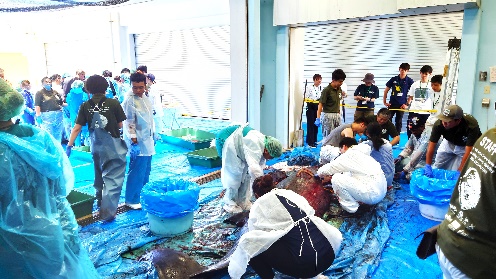
Necropsy of a Blainville’s beaked whale
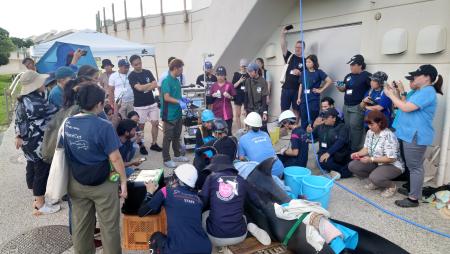
Hands-on training by veterinarian
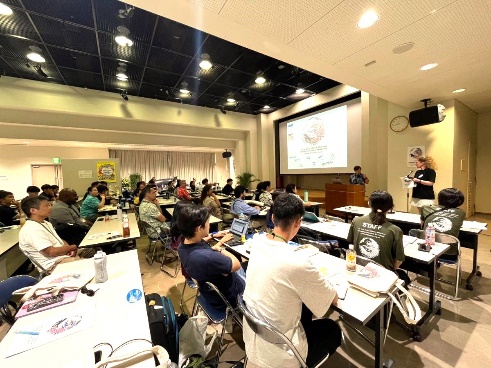
resentations & reports of case studies and activities from around the world
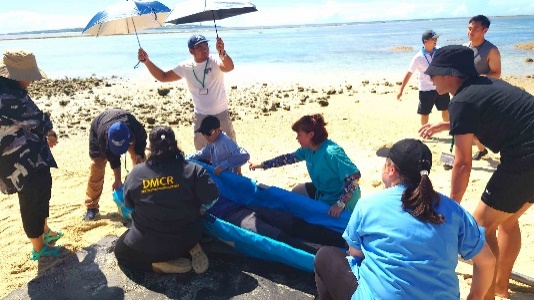
Training in how to deal with strandings at the beach
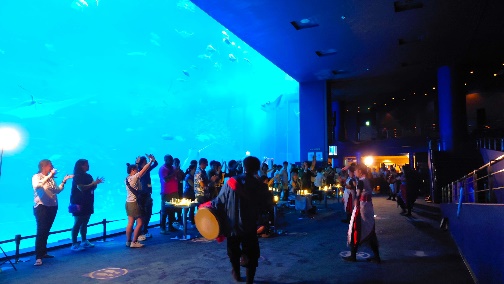
Eisa dance performance and banquet held at the aquarium
Monitoring body temperature and behavior of an Alfred manta: Revealing ecology with the latest technology
The Okinawa Churaumi Aquarium has begun field research to better understand Alfred manta behavior and physiology in natural conditions. This facility has reared this species for many years, and made discoveries about their sexual maturation※1 and reproduction※2. To research Alfred mantas in the wild, we attached a behavior monitoring device to an individual to record its swim speed and acceleration, plus the water depth and water temperature. An attached thermometer allows us to study how they maintain their body temperature when diving in cold deep waters. By comparing with our previous survey※3 on whale sharks, our goal is that through monitoring the behavior and physiological conditions of manta rays, we can gain understanding and help shed light on the ecology and conservation of this species.
Past research achievements
※1 Nozu R, Murakumo K, Matsumoto R, Matsumoto Y, Yano N, Nakamura M, Yanagisawa M, Ueda K, Sato K. 2017. High-resolution monitoring from birth to sexual maturity of a male reef manta ray, Mobula alfredi, held in captivity for 7 years: changes in external morphology, behavior, and steroid hormones levels. BMC Zool. 2(14).
※2 Murakumo K, Matsumoto R, Tomita T, Matsumoto Y, Ueda K. 2020. The power of ultrasound: observation of nearly the entire gestation and embryonic developmental process of captive reef manta rays (Mobula alfredi). Fishery Bulletin. 118: 1–7.
※3 Nakamura I, Matsumoto R, Sato K. 2020. Body temperature stability in the whale shark, the world's largest fish. Journal of Experimental Biology. 223 (11): jeb210286.
A deeper understanding of tawny nurse sharks ~Using the latest technology to reveal more about their ecology and conservation ~
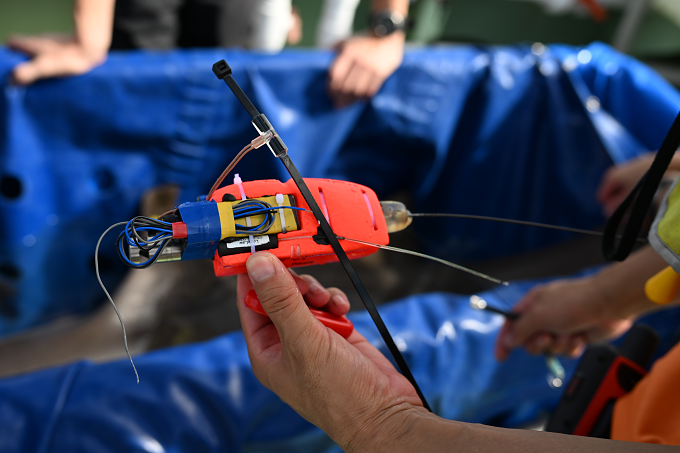
Recording devices used
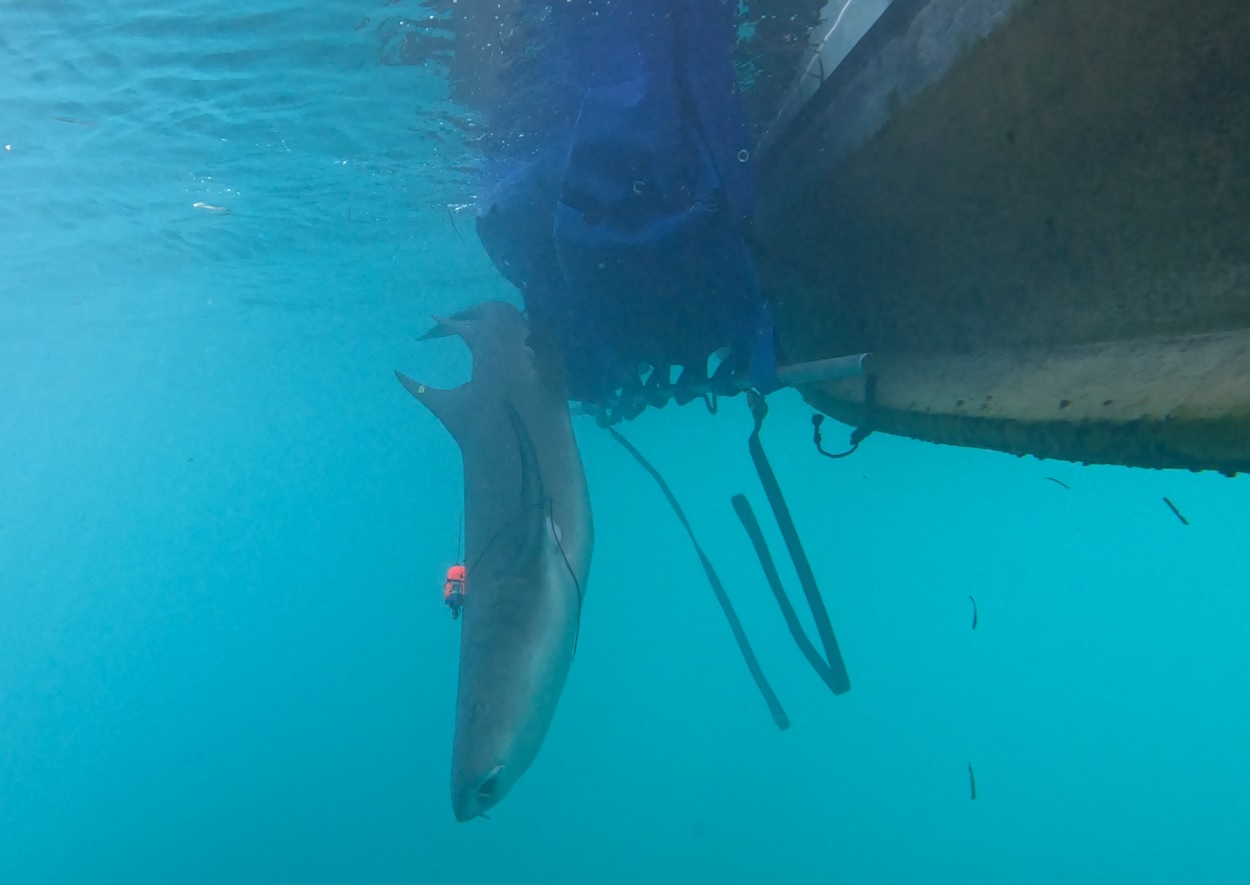
Tawny nurse shark release
Okinawa Churaumi Aquarium has started a field study of tawny nurse sharks to gain a deeper understanding of their ecology and physiology in the wild.
In Japan, tawny nurse sharks are mainly seen near the Yaeyama Islands, but knowledge of their behavioral ecology is limited. In this study, we attach a clinical thermometer, electrocardiogram, and a behavior logger to tawny nurse sharks. Using a timer, the gear automatically releases from the shark. The gear is collected by researchers who can then record and analyze the shark’s behavior and physical state in the wild.
Okinawa Churaumi Aquarium not only studies tawny nurse sharks in captivity (*), but now also conducts research in the wild. By studying behavior, physiology, and the genetics of Yaeyama populations, we aim to increase our knowledge of tawny nurse shark ecology and conservation.
* Publication
Tomita T, Murakumo K, Ueda K, Ashida H, Furuyama R. 2019. Locomotion is not a privilege after birth: Ultrasound images of viviparous shark embryos swimming from one uterus to the other. Ethology. 125: 122-126.
Aquarium staff members received an award for best technique and research at the Journal of Japanese Association of Zoos and Aquariums in 2024

Green turtles are threatened with extinction, and are therefore listed as an endangered species on the red list of the IUCN (International Union for Conservation of Nature). Since 1994, the staff at Okinawa Churaumi Aquarium, have studied the reproduction and physiological ecology of green turtles through captive breeding, with the goal of conservation.
Discovering the age of sexual maturation in sea turtles is extremely difficult, and the most effective method is through captive breeding. At our facility, we are rearing a female green turtle that was born at the aquarium in 1999. Each year we conduct an ultrasound scan of their ovaries, and measure their straight carapace length and body mass. The results showed that a reared female green turtle’s sextual maturation begins at around 22 – 23 years old with straight
【Authors】Isao Kawazu, Ken Maeda, Takahiro Kobuchi, Takahide Sasai, Kaho Mizuochi,
Kei Yamazaki, Konomi Maeda, Masakatsu Kino, Shingo Fukada
【Title】Suppression of aggressive behavior in a captive pygmy killer whale using behavior modification
【Journal】Journal of Japanese Association of Zoos and Aquariums 65 (2), 31–36, 2023. (in Japanese with English abstract)
Okinawa Churashima Foundation has signed a cooperation agreement with major overseas aquariums
Okinawa Churashima Foundation is pleased to share the announcement of cooperation agreements with Georgia Aquarium in America, Oceanogràfic València in Spain, and Oceanographic Institute in Monaco.
【The goals of the agreement】
We are collaborating with overseas aquariums that share our principals of addressing marine issues, conservation of biodiversity, and ex-situ breeding of rare species. Our aim is to strengthen the aquarium’s operational foundation through mutual interaction as we work to solve global issues, conduct research, promote education, and nurture future scientists.
Baby white shark sheds a layer of skin after birth
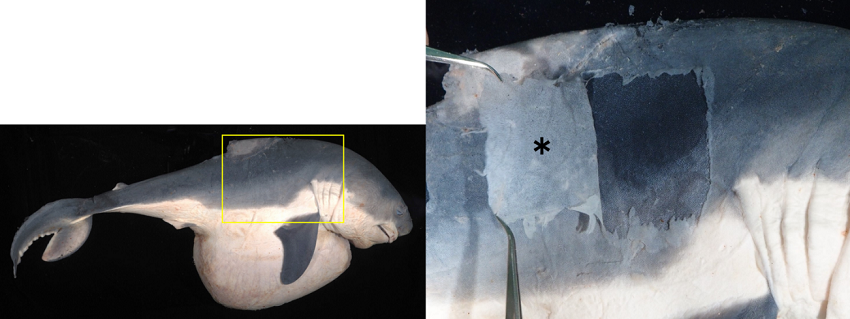
Embryo of a salmon shark (left) and its enlarged image on the (right). When the white layer of skin was removed *, the actual skin covered in scales appear.
In 2023, off the coast of California, North America, the world’s first newborn white shark was spotted. This discovery was important as it gave new information on the breeding grounds of white sharks as well as revealing a mysterious white membrane that covered the newborn’s body. Our team has identified this white membrane, and our findings were published in a scientific paper in an international academic journal.
Our research group studied the embryo of a salmon shark, the cousin of the white shark, and the white membrane on the pup’s skin. The membrane was initially thought to be made up of substances from the amniotic fluid, however, we found out that it was actually the skin of the embryo. The embryo has this additional white outer layer of skin over its scaly skin which is shed immediately after birth.
This phenomenon had not been previously studied, and our research will reveal new insights into the reproductive biology of the white shark.
【Title】Whitish film covering a newborn white shark was not intrauterine material but embryonic epithelium
【Authors】Taketeru Tomita, Kei Miyamoto, Masaru Nakamura, Kiyomi Murakumo, Minoru Toda, Keiichi Sato
【Journal】Environmental Biology of Fishes
【Journal link】https://link.springer.com/article/10.1007/s10641-024-01560-z
Scientific paper published on a new species in a new genus Churaumiastra hoshi

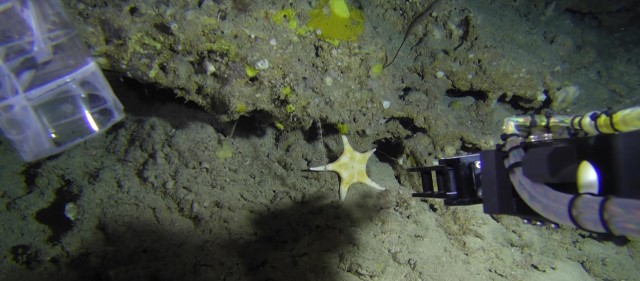
A mesophotic sea star collected from Okinawa has been described as a new species in a new genus.
This species belongs to the family Goniasteridae, the largest family of sea stars with 70 genera and over 160 species globally. The described specimen was found and collected by the aquarium’s remotely operated vehicle (ROV) off the coast of Onna Village, Okinawa at a depth of 247 meters. From surveys conducted with a ROV, we have documented its ecology and were able to observe it living amongst rocky reefs near species of Octocorallia which many species of Goniasteridae consume.
【Authors】Christopher L. Mah, Yoichi Kogure, Toshihiko Fujita , Takuo Higashiji (Bold letters: Staff of Okinawa Churaumi Aquarium)
【Title】New Taxa and Occurrences of Mesophotic and Deep-sea Goniasteridae
(Valvatida,Asteroidea) from Okinawa and adjacent regions.
【Journal】Zootaxa
2023
Publication of scientific paper on age and body characteristics of captive green turtles at the onset of sexual maturation!
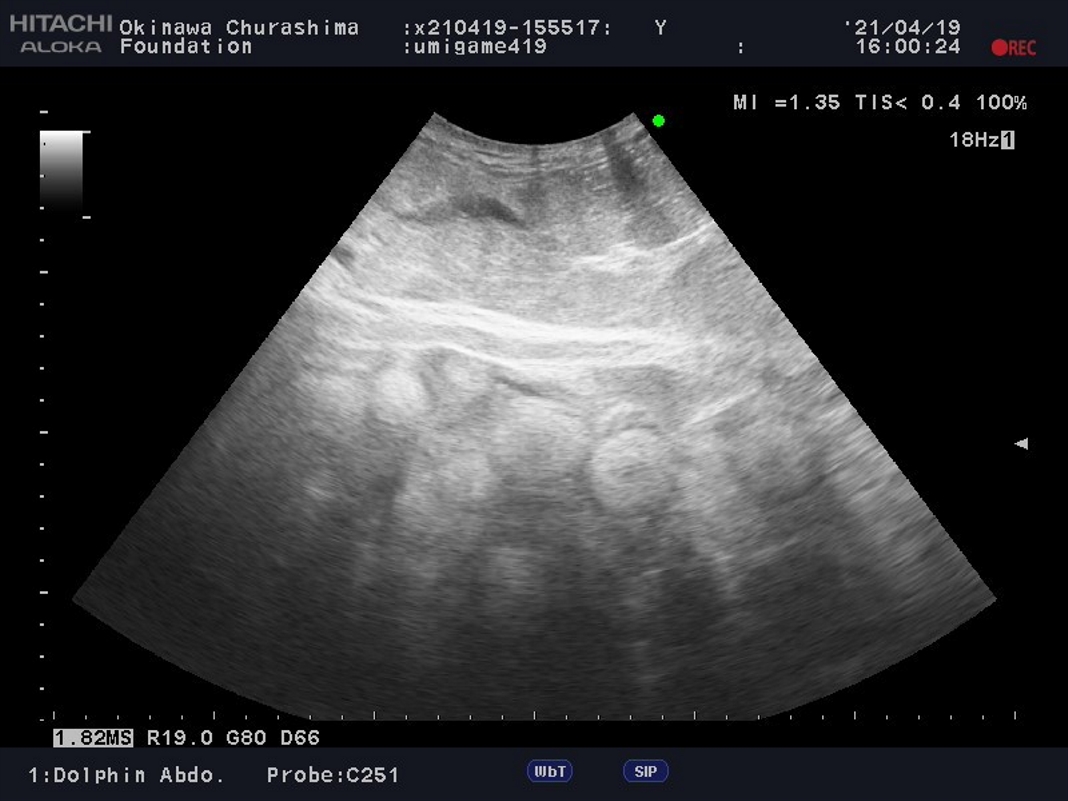
Green turtles are threatened with extinction, and are therefore listed as an endangered species on the red list of the IUCN (International Union for Conservation of Nature).
Since 1994, the staff at Okinawa Churaumi Aquarium, have studied the reproduction and physiological ecology of green turtles through captive breeding, with the goal of conservation. Discovering the age of sexual maturation in sea turtles is extremely difficult, and the most effective method is through captive breeding. At our facility, we are rearing a female green turtle that was born at the aquarium in 1999. Each year we conduct an ultrasound scan of their ovaries, and measure their straight carapace length and body mass. The results showed that a reared female green turtle’s sextual maturation begins at around 22 – 23 years old with straight carapace length 82.4–83.5 kg and body mass 100.4–105.0 kg.
【Author】 Isao Kawazu, Ken Maeda, Takahiro Kobuchi, Takahide Sasai, Kaho Mizuochi, Kei Yamazaki,
Konomi Maeda, Masakatsu Kino, Shingo Fukada (Bold letters: the Churashima Foundation Staff)
【Journal】 Journal of Japanese Association Zoos and Aquariums
Latest news about the artificial uterus apparatus for sharks! Successful stable rearing of shark pups born from an artificial uterus.
 Mollers lantern shark pup in an artificial uterus(left)and pups after their birth(right)
Mollers lantern shark pup in an artificial uterus(left)and pups after their birth(right)Our facility has been developing an artificial uterus apparatus for the ex-situ conservation of rare sharks.
Between 2021to 2022, using the artificial uterus apparatus, we reared pups of the deap-sea Mollers lantern shark, for the second time. Although births didn’t occur in the first attempt, our second attempt succeeded in the world’s first stable rearing of the pups, and our results were published in an international scientific journal.
From two months prior to "birth", the hatchlings were slowly acclimatized to seawater, after birth there were given a special easily digestible diet. These factors helped the project succeed.
【Authors】Taketeru Tomita, Minoru Toda, Atsushi Kaneko, Kiyomi Murakumo, Kei Miyamoto, Keiichi Sato (Bold letters: the Okinawa Churashima Foundation Staff)
【Title】Successful delivery of viviparous lantern shark from an artificial uterus and the self-production of lantern shark luciferin
【URL of the scientific paper】(Free to view)https://journals.plos.org/plosone/article?id=10.1371/journal.pone.0291224
【Journal】PLOS ONE
Publication of a scientific paper on the birth and nursing of false killer whales in captivity!
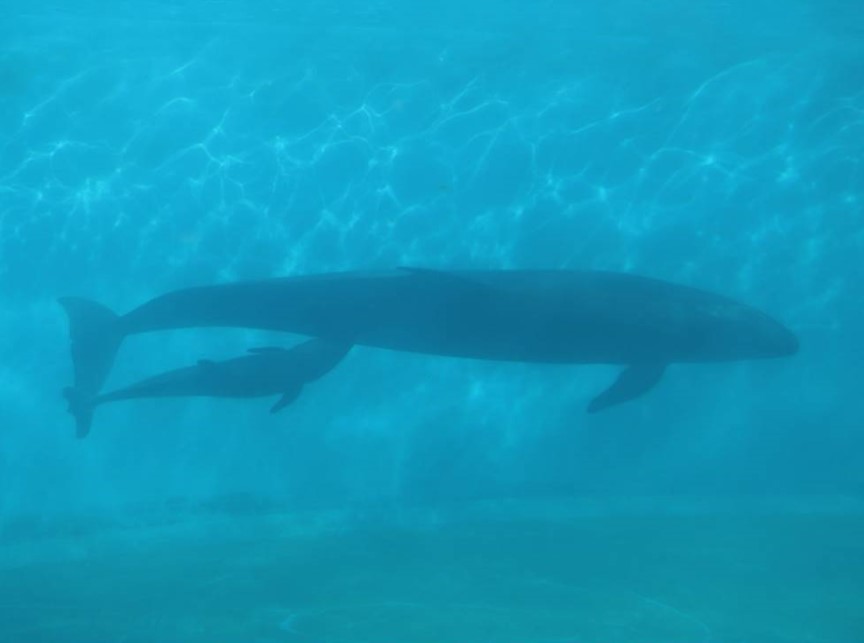
False killer whales are found in warm waters around the world. There are only a few cases of captive rearing in aquariums.
On May 23rd, 2017, Okinawa Churaumi Aquarium had the world’s fourth successful captive breeding of a false killer whale. Cetacean births usually take place tail-first (podalic), however, this time the baby was born head-first (cephalic). This is the world’s first confirmed case of a false killer whale born head-first. The birth took nine hours, and 16 hours later it began nursing. It showed that a successful birth followed by nursing can take place even when a false killer whale is born head-first.
The results of this study will help to improve techniques for captive breeding of false killer whales.
【Authors】Suguru Higa, Yuuta Mitani, Shunya Ikeshima, Nozomi Kobayashi, Keiichi Ueda and Isao Kawazu (Bold letters: the Okinawa Churashima Foundation Staff)
【Title】Parturition and Nursing Events in a Cephalic Birth of a False Killer Whale (Pseudorca crassidens) in Managed Care
【Journal】Aquatic Mammals
Publication of “The Churaumi Twilight Zone” a picture book about strange but beautiful deep-sea creatures.

“The Churaumi Twilight Zone: A wonderland of mysterious deep-sea creatures” is a new picture book about strange but beautiful deep-sea creatures, written by the staff of Okinawa Churaumi Aquarium and The Okinawa Churashima Foundation. The foundation and the aquarium have conducted over 800 surveys of deep-sea creatures and have discovered 920 species of deep-sea creatures. The book introduces these strange but beautiful deep-sea creatures with photos that were taken by our aquarists.
【Authors】Keiichi Sato (ed.), Deep Sea Exhibition Team of Okinawa Churaumi Aquarium
【Publisher】Sangyo Henshu Center Co.,Ltd.
A scientific paper written by researchers of Okinawa Churashima Foundation was one of the top cited articles of Marine Mammal Science in 2021-2022!
 Humpback whale breaching (Top left). Summary of the results of the paper showing diurnal variation in song activity (Bottom left). Award details (Right)
Humpback whale breaching (Top left). Summary of the results of the paper showing diurnal variation in song activity (Bottom left). Award details (Right) The research group of Okinawa Churashima Foundation wrote a scientific paper on the diurnal variation of humpback whale songs in Okinawa. It was published in the academic journal Marine Mammal Science.
The paper became one of the top cited articles in the journal between January 1st, 2021 and December 15th, 2022.
The article can be viewed using the following link.
https://churashima.okinawa/ocrc/marine_organisms/report/1668489623/
【Journal link】 DOI: 10.1111/mms.12790
Paper published on the migration of humpback whale populations between four areas of Japanese waters.
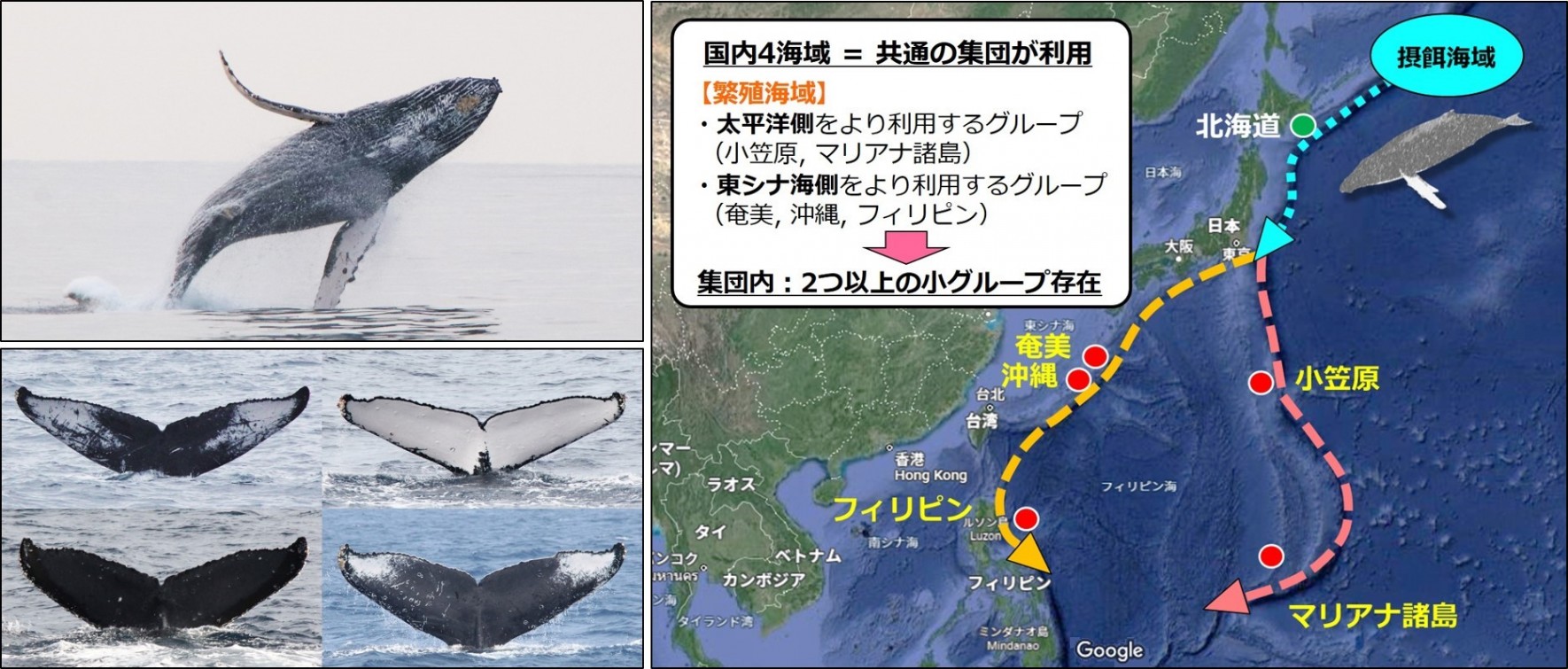
Humpback whale breaching (Top Left) Characteristics of the tail fins of each whale (bottom left) and a schematic of the research results (right)
Humpback whales feed in high latitude waters during summer, and breed (mate, give birth and rear) in lower latitudes during winter. In the western North Pacific Ocean, the humpback whales feed off the coast of Russia. Their breeding grounds are in the Japanese waters of Okinawa, Amami, and Ogasawara plus the Philippines waters of the Mariana Islands. Some of the whales migrate past Hokkaido. It is possible to identify individual humpback whales based on the patterns and shapes of their flukes. To understand the movement and interchange between domestic waters, research teams from Okinawa Churashima Foundation, Everlasting Nature of Asia (ELNA) (Tokyo Metropolis, Ogasawara Village), Ogasawara Whale Watching Association (Tokyo Metropolis Ogasawara Village), Amami Whale and Dolphin Association (Kagoshima Prefecture, Amami City), Field Science Center for Northern Biosphere, Hokkaido University (Hokkaido, Hakodate City), and the Cybermedia Center, Osaka University (Ibaraki City, Osaka Prefecture) studied photos of 3,532 humpback whale flukes taken in 4 domestic regions of water (Okinawa, Ogasawara, Amami and Hokkaido) between 1989 and 2020. An automated matching system was used to compare flukes. The results showed 3 matching whales comparing Okinawa and Hokkaido, 225 whales comparing Okinawa and Ogasawara, 222 whales comparing Okinawa and Amami, and 36 whales comparing Ogasawara and Amami. Based on the number of these matched individuals, the indices were calculated on interchanges between waters and each region’s recurrence, and it has shown that 4 domestic water regions are most likely used by a single common group. Also, the frequency of interaction is different between areas, suggesting that two small groups may exist. One group may utilize the Philippine Sea route (Ogasawara and Mariana Islands) and the other group the East China Sea route (Amami, Okinawa and the Philippines). These discoveries are valuable for conservation of humpback whales in Japan. We will continue to collaborate with research teams, and aim to unravel the details of humpback whale population structures using DNA analysis.
【Authors】 Nozomi Kobayashi, Satomi Kondo, Koki Tsujii, Katsuki Oki, Masami Hida, Haruna Okabe, Takashi Yoshikawa, Ryuta Ogawa, Chonho Lee, Naoto Higashi, Ryosuke Okamoto, Sachie Ozawa, Senzo Uchida, Yoko Mitani (Bold letters: the Churashima Foundation Staff)
【Title】 Interchanges and movements of humpback whales in Japanese waters: Okinawa, Ogasawara, Amami, and Hokkaido, using an automated matching system
【Journal】 PLOS ONE
【Journal link】 https://doi.org/10.1371/journal.pone.0277761
Innovative water sampling method to detect habu kurage box jellyfish
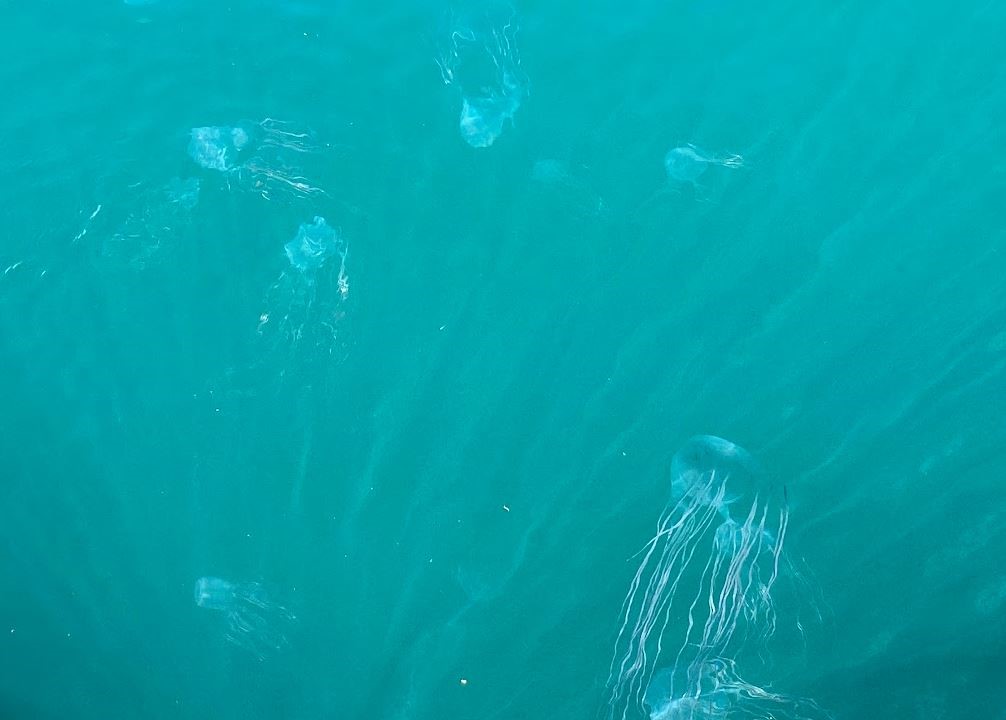
Outbreak of habu kurage box jellyfish at a fishing port
Okinawa Churashima Foundation is researching environmental DNA. By examining a water sample for DNA fragments, and identifying the species the fragments come from, you can reveal what creatures are living in that body of water. Our foundation has collaborated with the Okinawa Prefectural Institute of Health and Environment to develop a method using environmental DNA to detect the presence of venomous habu kurage box jellyfish. These jellyfish are a danger to people visiting Okinawa’s beaches and ports. This method could alert people to the presence of the habu kurage box jellyfish even when they are not visible to the naked eye. It could also reveal the habitat of the larvae, which is not clear. This new method will be tested outdoors to reveal the ecology of habu kurage box jellyfish, and improve ocean safety.
【Authors】Yasuhito Azama, Shin-ichiro Oka, Morimi Teruya, Sho Toshino, Miyako Tanimoto, Nozomi Hanahara, Yumani Kuba,
Ayano Miyagi and Yoshimune Fukuchi(Bold letters: the Churashima Foundation Staff)
【Title】Real-time PCR assay for detection of Environmental DNA from Chironex yamaguchii
【Journal】 Medical Entomology and Zoology
【Journal link】 https://www.jstage.jst.go.jp/article/mez/74/1/74_2213/_article/-char/ja/
Paper published on the sterilization of male tilapia to reduce population.
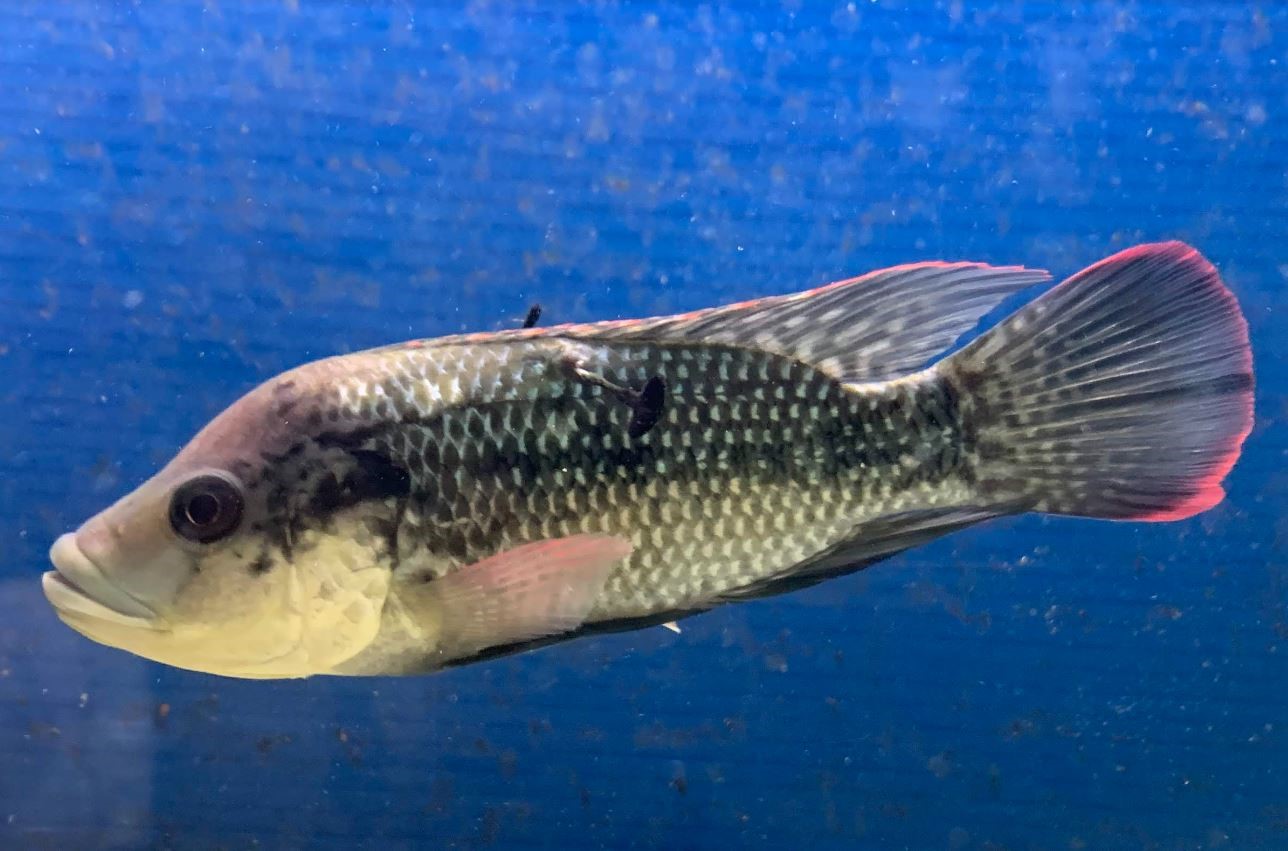
Mozambique tilapia are native to Africa. They are an invasive species in Okinawan waters and their effects on the local ecosystem is causing concern.
The Okinawa Churashima Foundation conducted an experiment to reduce the local population of tilapia by releasing infertile males. Young male tilapia were temporarily reared at high temperatures to cause them to become infertile. As tilapia spawn in pairs, releasing infertile males into the wild was predicted to be effective.
For three years, researchers reared and released sterilized tilapia into the artificial pond inside Ocean Expo Park. The results showed that it was possible to sterilize most of the males that hold breeding territories. However, there was no clear evidence of any reduction in the population size, and the conclusion was that that there was no significant effect in releasing sterilized males. This trial was the first attempt to reduce population size using infertile males in vertebrates, and the effect was not what was expected.
We believe this result shows the high reproductive ability of tilapia which underlines the challenges of eradicating this non-native species.
Okinawa Churashima Foundation will continue to conduct scientific research to solve the various environmental issues facing Okinawa including the Yanbaru region which is a natural UNESCO World Heritage Site.
【Authors】Shin-ichiro OKA, Ryo NOZU, Kei MIYAMOTO, Taketeru TOMITA, Nozomi HANAHARA, Chihiro YAMAUCHI,
Takahide SASAI and Masaru NAKAMURA (Bold letters: the Churashima Foundation Staff)
【Title】A trial to control invasive Mozambique tilapia populations using the sterile-male release technique in the artificial ponds on Okinawa
【Journal】Biological Magazine Okinawa
Scientific paper published on the genetic research advances our understanding of whale shark vision
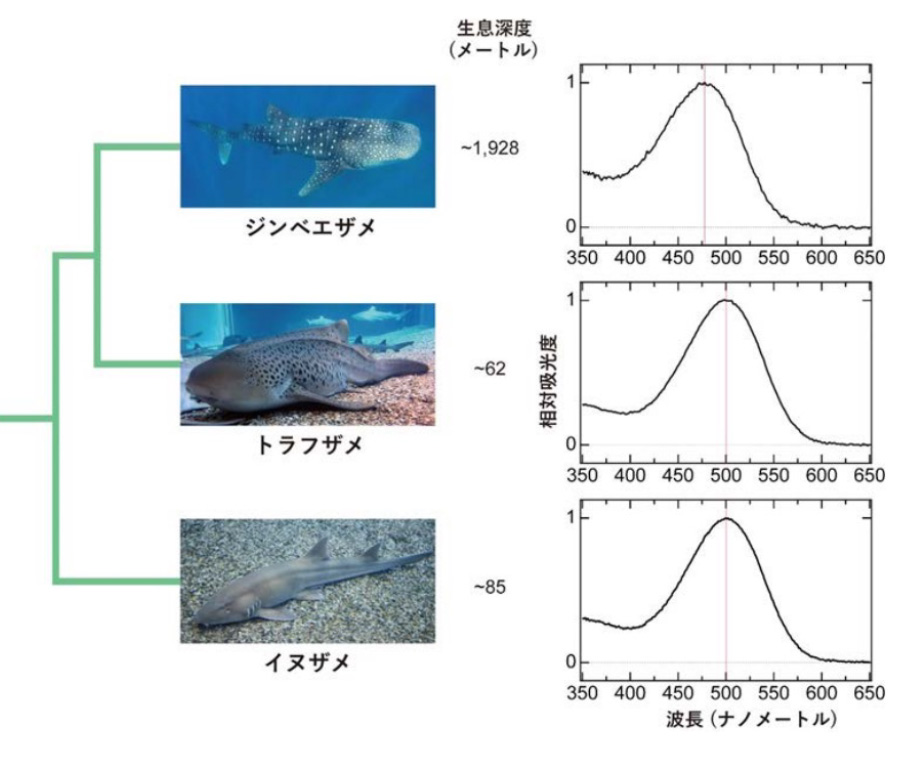
Whale sharks filter feed for zooplankton at the ocean's surface. Researchers have tracked and logged whale shark movements with data logging devices, and found that whale sharks also dive down to the dark deep sea. As whale sharks live in both well-lit surface waters and dark depths, how do their eyes manage this challenge?
A scientific paper published on a new species of huge deep-sea andvakiid anemone.
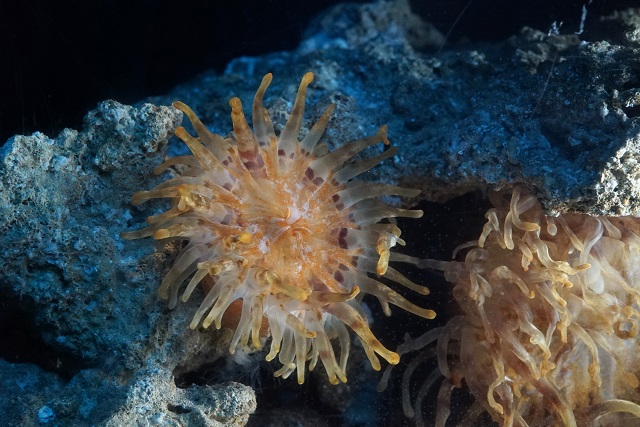
A new species of deep-sea anemone was collected from the Okinawa Islands, described, and given the Japanese name ryugunogoten. It is in the genus Telmatactis of which there are approximately 30 species globally. Most of these anemone species were described during the 19th or early 20th century. This is the first new species to be recorded in this genus in the 21st century.
The specimen was collected by a remotely operated vehicle (ROV) at a depth of 206 meters off of Ishigaki Island, Okinawa Prefecture. The ROV survey was successful in capturing footage of this species hiding behind rocks, living inside the hole of sponges, and with many pandalid shrimp.
【Authors】Takato Izumi, Takuo Higashiji(Bold letters: the Churashima Foundation Staff)
【Title】Gigantic anemone species in the deep ‘churaumi’ ? description of a new species of the genus Telmatactis (Cnidaria: Anthozoa: Actiniaria: Metridioidea), Telmatactis profundigigantica sp. nov.
【Journal】Species Diversity
Scientific paper published on ecological study of wild whale sharks
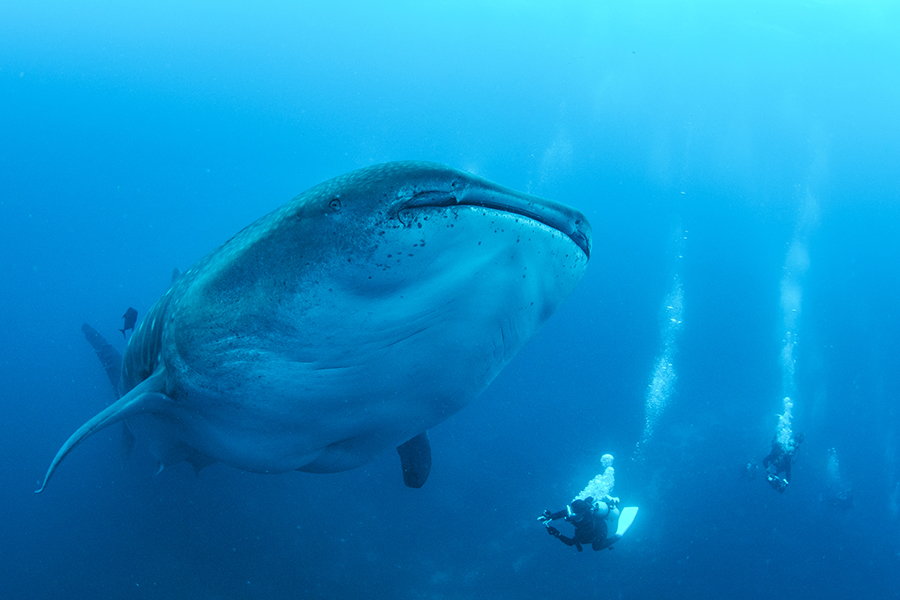
The Galapagos Marine Reserve is the only known place in the world that mature female whale sharks migrate to. Most of these females are believed to be pregnant. Okinawa Churashima Foundation has collaborated with the Galapagos Whale Shark Project (Ecuador), Universidad San Francisco de Quito USFQ (Ecuador), Galápagos National Park (Ecuador), Georgia Aquarium (USA), Galapagos Conservation Trust (UK) and Marine Megafauna Foundation (USA), in conducting field research to shed light on the reproduction ecology of whale sharks. The methods developed by Okinawa Churaumi Aquarium to monitor the health of our captive large elasmobranchs, such as conducting underwater ultrasonography and blood sampling were used to study wild whale sharks in the ocean. As a result, for the first time in the world, researchers detected ovarian follicles (egg precursors) with diameters from 28.5mm to 83.6mm in two whale sharks.
A shark’s intestine functions like a wet towel!?
Shark intestines have a very unusual structure. From the outside they are tube-shaped but inside they have a spiral-shaped structure. The reason for this spiral structure is not completely clear.
Recently, we discovered a possible answer to this mystery. By using ultrasound, we could view the movement of the intestine while Jinta, the aquarium’s whale shark, was digesting. It showed Jinta twisting the intestine during digestion. It always twists to the right which winds the spiral structure tighter.
Like wringing water out from a cloth, it suggests that sharks twist their intestine to help excrete feces from its anus.
This new knowledge was possible through the rearing of the whale shark at the aquarium. We will continue to study reared animals to further contribute to our knowledge of organisms.
【Title】Narrowing, twisting, and undulating: Complicated movement in shark spiral intestine inferred using ultrasound
【Authors】Taketeru Tomita, Kiyomi Murakumo, Rui Matsumoto (Bold letters: the Churashima Foundation Staff)
【Journal】Zoology
Scientific paper published on the genetic research advances our understanding of whale shark vision
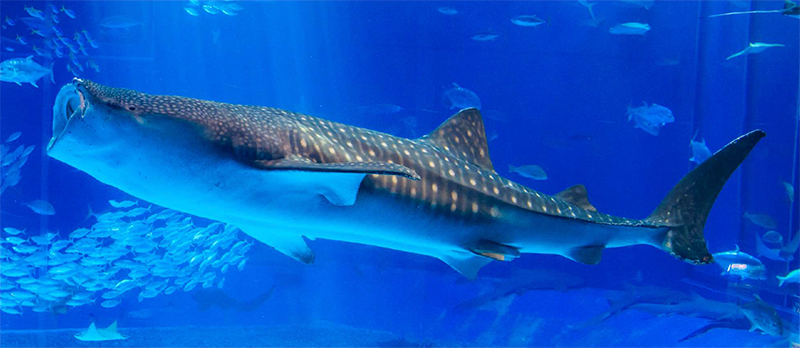
Whale sharks filter feed for zooplankton at the ocean's surface. Researchers have tracked and logged whale shark movements with data logging devices, and found that whale sharks also dive down to the dark deep sea. As whale sharks live in both well-lit surface waters and dark depths, how do their eyes manage this challenge?
Researchers from Okinawa Churaumi Aquarium collaborated with research teams led by Professor Shigehiro Kuraku of Research Organization of Information and Systems National Institute of Genetics (Team leader of RIKEN) and Professor Mitsumasa Koyanagi of Osaka Metropolitan University, to research how genetics influences the vision of whale sharks.
【Title】Whale shark rhodopsin adapted to deep sea lifestyle by a substitution associated with human disease
【Authors】Kazuaki Yamaguchi, Mitsumasa Koyanagi, Keiichi Sato, Akihisa Terakita, Shigehiro Kuraku
2022
Genetic connections between species of anemones that are symbiotic with anemonefish found by studying their tentacles!
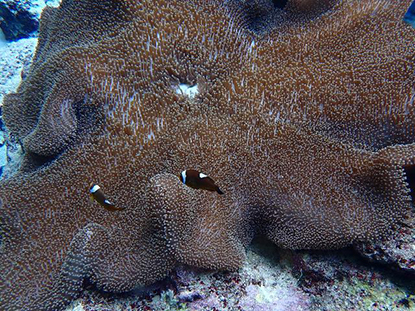
The symbiotic relationship between species of anemonefish and sea anemones is well known. This study used genetic analysis to reveal phylogenetic differentiation in the host sea anemones. The results allow a deeper understanding of the interactions between sea anemones and anemonefish, including differences in toxicity of the host anemones.
【Authors】Rio Kashimoto, Miyako Tanimoto, Saori Miura, Noriyuki Satoh, Vincent Laudet, Konstantin Khalturin (Bold letters: the Churashima Foundation Staff)
This study was conducted with staff from the Churashima Foundation in collaboration with the Okinawa Institute of Science and Technology.
【Title】Transcriptomes of Giant Sea Anemones from Okinawa as a Tool for Understanding Their Phylogeny and Symbiotic Relationships with Anemonefish
【Journal】Zoological Science
Collaborative study with overseas research teams on the impact of whale watching and whale tourism on humpback whales
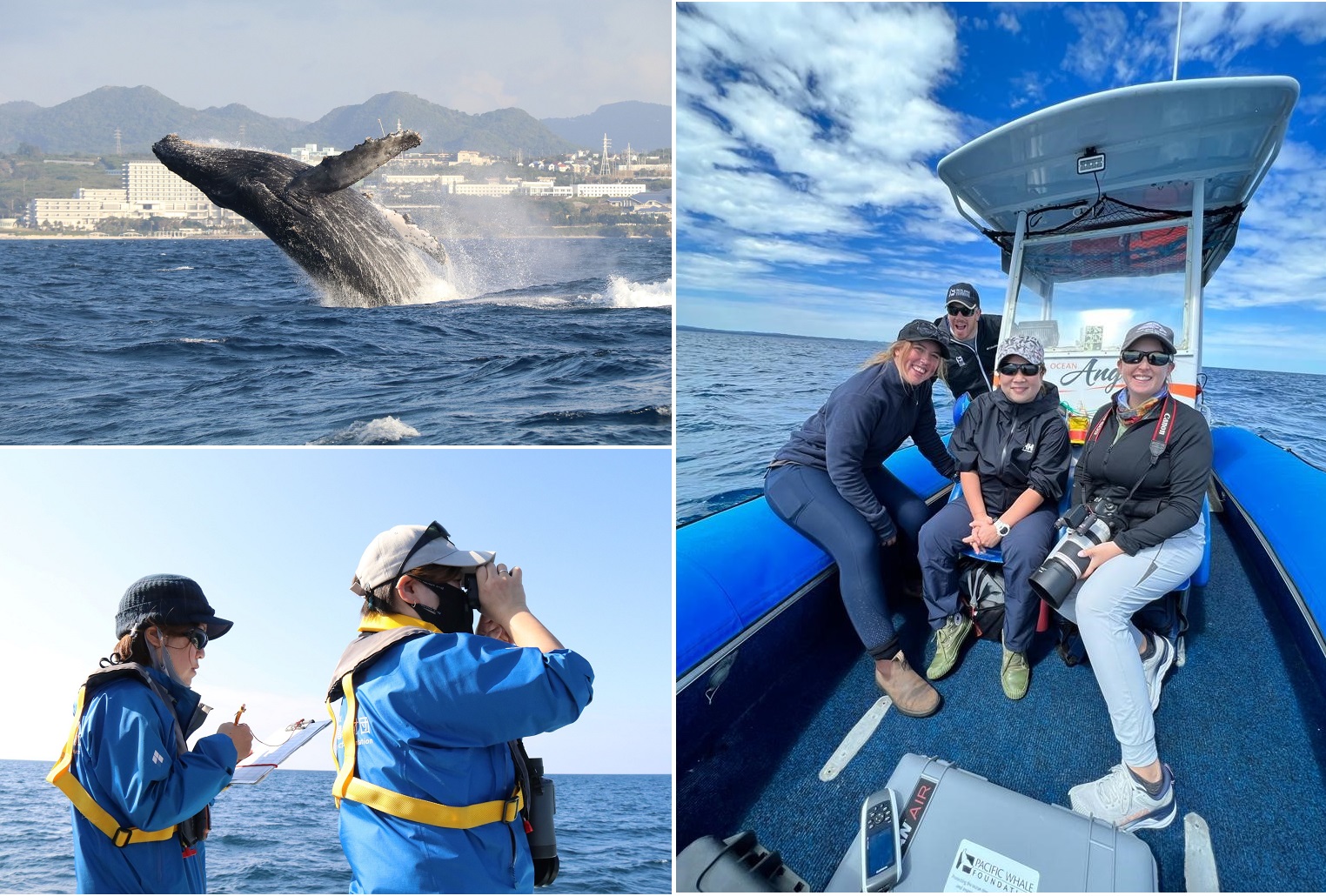
In recent years, humpback whale watching has become increasingly popular in Japan. In some areas, businesses have started to offer whale swim tours. Overseas studies suggest that an expanding tourism industry may lead to disturbance or stress to the animals, which can have long-term impacts. Long term impacts can include having fewer calves, decreased life span, and/or abandoning an area. It is important to establish rules to help minimize the impact on cetaceans while maintaining a sustainable tourism industry.
The Okinawa Churashima Foundation Research Center, with the aims of humpback whale conservation and sustainable tourism, has collaborated with Dr. Stephanie Stack of the Pacific Whale Foundation. Dr. Stack and her team have extensive experience in many places in the world, studying the impact of human activities, including tourism, on cetaceans. By working with people in related industries, we are better able to study and evaluate the effects of whale watching and swim tours. We will continue to study this issue while collaborating with related industries and research institutions in Japan and overseas!
First discovery of the tiny thread pipefish in Japanese waters
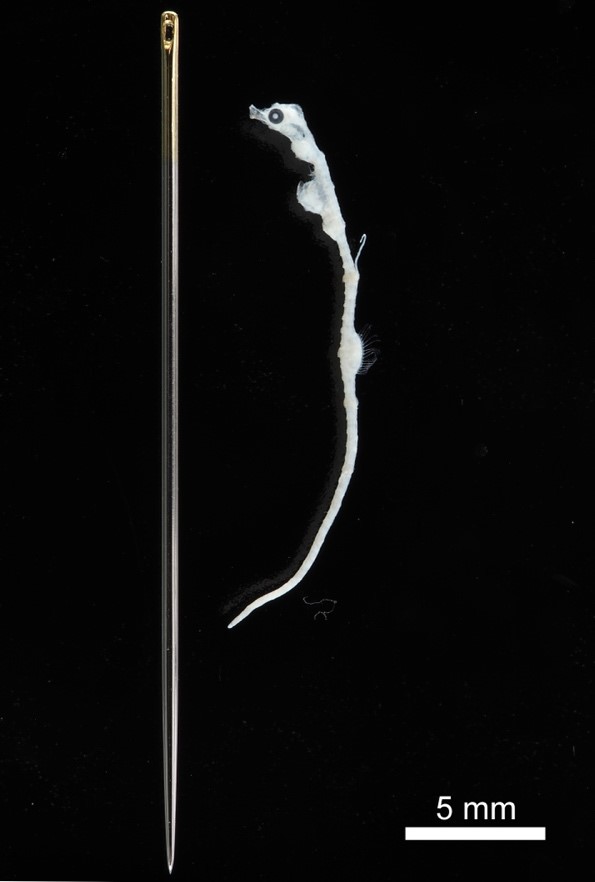
The first thing you notice about the thread pipefish is that it is tiny. The research group at the Okinawa Churashima Foundation collected an extremely small fish at a depth of 8 meters off the coast of Motobu. The specimen was confirmed to be Kyonemichthys rumengani, a species of pipefish that had not been found in Japanese waters. Some scuba divers thought that this species was found in Japan, however, this was the first confirmed specimen. Observations of its structure and genetics, reveal it is closely related to the Urocampuspipefishes found in inland bays and brackish waters. Its Japanese common name is proposed to be hariyouji, because it resembles a needle.
【Authors】Nozomi Hanahara, Miyako Tanimoto,Naoki Shirakawa (Bold letters: the Churashima Foundation Staff)
【Title】Kyonemichthys rumengani (Teleostei: Syngnathidae) is sister taxon to the pipefish genus Urocampus: genetic and morphological evidence
【Journal】Species Diversity DOI: 10.12782/specdiv.27.293
First confirmation in Japanese waters of the brackishwater frogfish
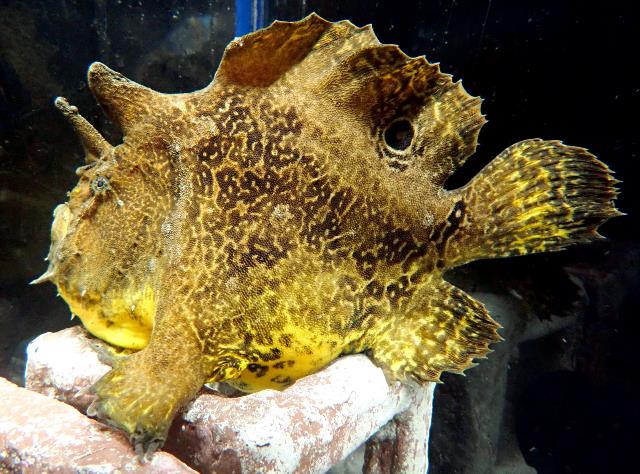
Frogfish use their limbs-like pectoral and pelvic fins to “walk” around the sea floor. There are over 50 species of frogfish around the world. Most frogfish are marine species, however the brackishwater frogfish is unusual in that is found in brackishwater and freshwater. This species was confirmed in the tropics south of Taiwan. However, the authors have confirmed this species to also inhabit near Okinawa Island and Yakushima Island. These were the first records of the species in Japanese waters. Its triangular head is like a clown’s hat which led to its Japanese name piero-kaeruanko. Okinawa Churaumi Aquarium successfully reared and exhibited the individual collected in a northern Okinawan river.
【Authors】Kei Miyamoto, Hidetoshi Wada, Tadanosuke Nagasaka, Hauraka Takano, Hiroyuki Motomura, and Hiroshi Senou (Bold letters: the Churashima Foundation Staff)
【Title】First Japanese records of Antennarius biocellatus (Antennariidae) from Okinawa-jima and Yaku-shima island
【Journal】Ichthy, Natural History of Fishes of Japan
The daily patterns in the singing activity of male humpback whales revealed!

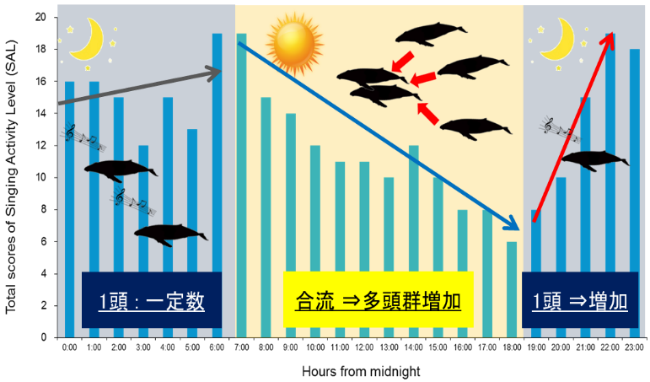
Male humpback whales produce complex sounds called songs. These songs are heard from the end of the feeding season and throughout the breeding season. Singing songs is thought to be related to breeding.
In the breeding grounds, males form competitive groups searching for females to mate with. These groups usually form just after sunrise, and they remain together during the day. In the afternoon and evening the groups reduce in size, and then break up.
Researchers from the Okinawa Churashima Foundation set up a fixed underwater microphone off the Motobu Peninsula in Okinawa Prefecture. The device recorded 24 hours a day, for 2 weeks during the breeding season. The recordings showed that whales sang more during the night than during the day. Observation surveys conducted from boats, indicated that males only sing when alone.
These results suggest that perhaps song activity is reduced during the day as male humpback whales are more likely to be in groups, and there are fewer males alone. However, male humpback whales may also be moving to different areas from day to night. To study this, researchers will place several fixed underwater microphones further offshore and continue with their research.
【Authors】Nozomi Kobayashi, Haruna Okabe, Naoto Higashi, Hirokazu Miyahara H, Senzo Uchida (Bold letters: the Churashima Foundation Staff)
【Title】Diel patterns in singing activity of humpback whales in a winter breeding area in Okinawan (Ryukyuan) waters
【Journal】Marine Mammal Science DOI: 10.1111/mms.12790
Development of a simple method for filtering environmental DNA samples.
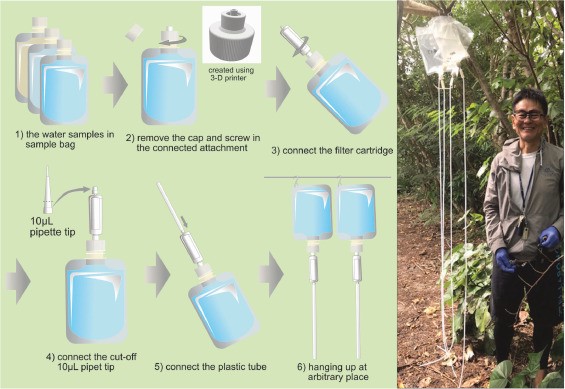
When conducting environmental DNA surveys to determine what species are in the water, it is necessary to filter the water that contains DNA. Previously, expensive equipment and tools were needed to do this. We developed a system, powered by gravity, to filter the water using a rubber hose and a 3D printed adapter. With this inexpensive and compact tool, we can filter outdoors without electricity. It is hoped that this will enable more environmental DNA surveys to be undertaken. Detailed information is in the published scientific paper, and several scientists are now using this system for their research.
【Authors】Shin-ichiro Oka, Masaki Miya, Tetsuya Sado (Bold letters: the Churashima Foundation Staff)
【Title】Gravity filtration of environmental DNA: A simple, fast, and power-free method
【Journal】Methods X
Are sclerites the key to sea pen evolution?
Revealing a new aspect of sea pen evolution!
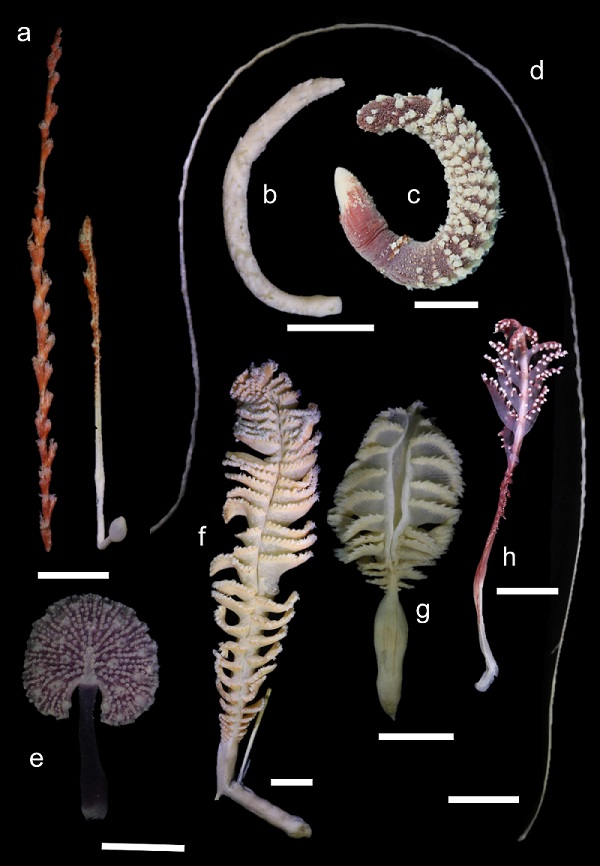
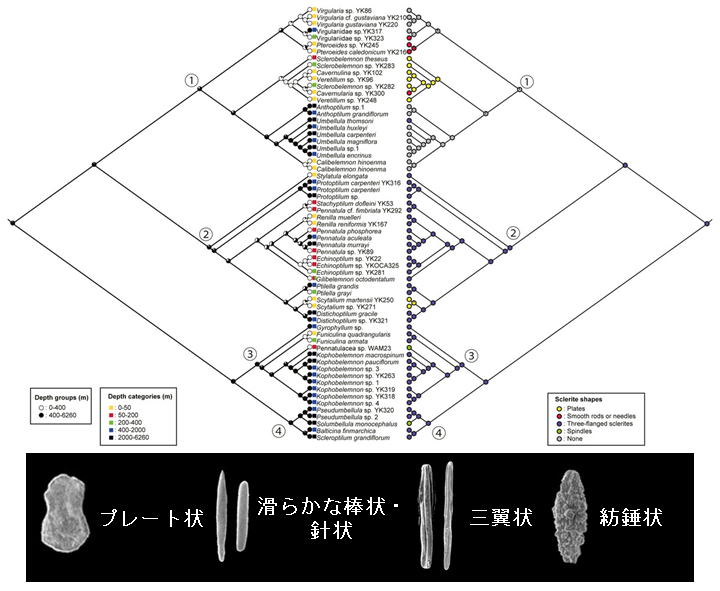
Sea pens are marine cnidarians that live in both shallow waters and deep seas around the world. They have tiny crystal-like internal structures called sclerites that vary in shape.
In our research, we found that these sclerites have variations related to the depth at which particular sea pens are living. A distinct evolutionary pattern was discovered. A common ancestor of sea pens, found at depths below 400 meters, has different plate and needle shaped sclerites to those sea pens at shallower depths.
【Authors】Kushida Y, Imahara Y, Wee HB, Fernandez-Silva I, Fromont J, Gomez O, Wilson N, Kimura T, Tsuchida S, Fujiwara Y, Higashiji T, Nakano H, Kohtsuka H, Iguchi A, Reimer JD.
(Bold letters:Staff members of Okinawa Churashima Foundation)
※This research was an international collaboration between research teams that included Okinawa Churaumi Aquarium, the University of Rissho, and the University of the Ryukyus.
【Title】Exploring the trends of adaptation and evolution of sclerites with regards to habitat depth in sea pens.
【Journal】Peer J
Scientific paper published on how paintpot cuttlefish walk!
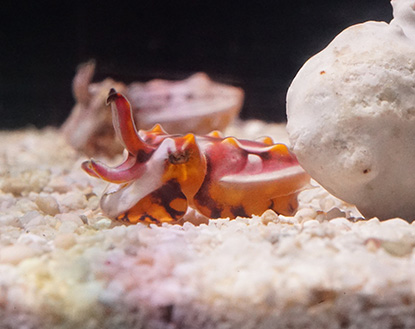
Most squid and cuttlefish swim, but the paintpot cuttlefish is unusual in that it prefers to walk. It uses its ventral arms like forelimbs, and its body’s mantle like rear legs to walk.
We observed the cuttlefish’s walking behavior and morphology to better understand the mechanism by which the mantle is used for walking.
Publication of scientific paper on the breeding of a third-generation loggerhead turtle!
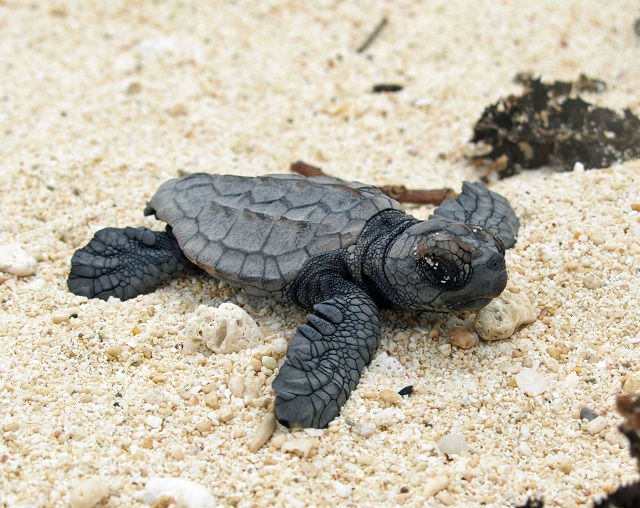
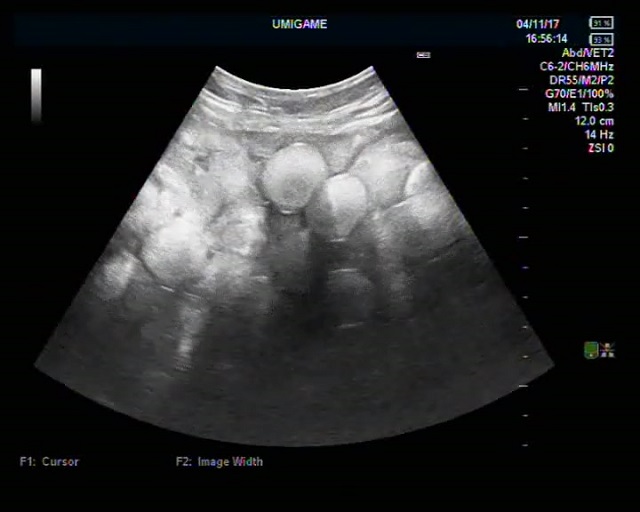
Japan is the main nesting ground for loggerhead turtles in the Northern Pacific. Egg laying takes place from Honshu down to the Ryukyu Islands, and is centered on Yakushima Island. The number of egg-laying loggerhead turtles has declined since 1990. They are threatened with extinction, and are therefore listed as an endangered species on the red list of the IUCN (International Union for Conservation of Nature).
Since 1994, the staff at Okinawa Churaumi Aquarium, have studied the reproduction and physiological ecology of loggerhead turtles through captive breeding, with the goal of conservation.
Discovering the age of sexual maturation in sea turtles is extremely difficult, and the most effective method is through captive breeding. At our facility, we are rearing a female loggerhead turtle that was born at the aquarium in 1995. Each year we conduct an ultrasound scan of her ovaries, and measure the length of her carapace. The results showed that a reared loggerhead turtle’s sextual maturation begins at around 18 – 22 years old. These results, including the successful breeding of a third successive generation of loggerhead turtle were published in the Herpetological Review, a journal published by the American Society for the Study of Amphibians and Reptiles.
【Author】Shingo Fukada, Isao Kawazu, Ken Maeda, Takahiro Kobuchi, Masae Makabe, Masakatsu Kino, Konomi Maeda, Mariko Omata, Takahide Sasai
【Title】Breeding Success of a Captive F2 Generation of Loggerhead Sea Turtle in Okinawa Churaumi Aquarium
【Journal】Herpetological Review
Long-term monitoring of egg-laying cycle using ultrasonography reveals the reproductive dynamics of circulating sex steroids in an oviparous catshark, Scyliorhinus torazame.

Noninvasive and stress-free ultrasound scans were successfully conducted to determine the spawning cycle of an oviparous catshark. The ultrasound scans were conducted every day on the same catshark for approximately six months.
Aquarium staff members received an award for best technique and research at the Journal of Japanese Association of Zoos and Aquariums in 2022
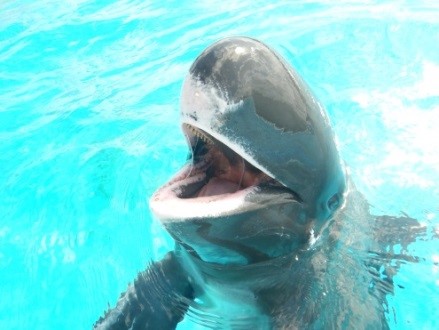
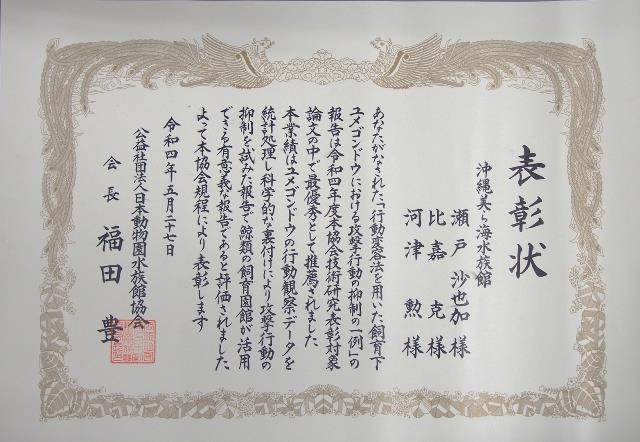
【Date awarded】May 27th, 2022
【Authors】Sayaka Seto, Suguru Higa, Isao Kawazu
【Title】Suppression of aggressive behavior in a captive pygmy killer whale using behavior modification
【Journal】Journal of Japanese Association of Zoos and Aquariums 66 (3), 42?50, 2021. (in Japanese with English abstract)
Scientific paper published on the speed of digestion in an Indo-Pacific bottlenose dolphin!
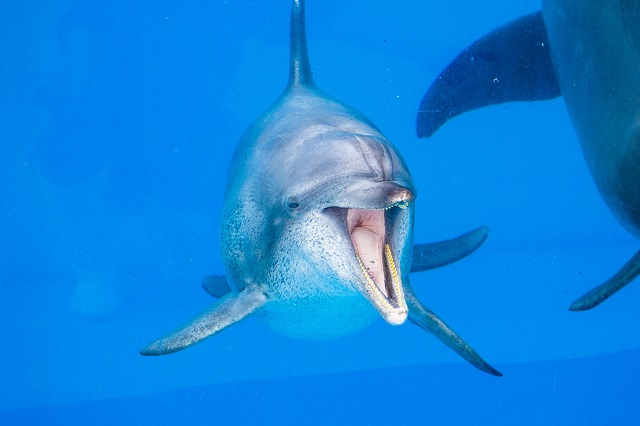
The Indo-Pacific bottlenose dolphin is a small species of toothed whale. They are found in warm coastal areas from the Indian Ocean to the Pacific Ocean.Okinawa Churaumi Aquarium is the only place in Japan that rears them. Kindai University and the Okinawa Churashima Foundation collaborated and conducted a study on the speed of digestion in a reared Indo-Pacific bottlenose dolphin. An Indo-Pacific bottlenose dolphin was given food with a capsule of red carmine dye. Researchers then recorded when this red dye first appeared in the dolphin’s feces. The results showed that it took an average of 254 ± 20.4 minutes for the dye to be first excreted. This suggests that Indo-Pacific bottlenose dolphins excrete within 4 to 6 hours from feeding. The results from this study provide valuable information, allowing a better understanding of feeding and behavior of wild Indo-Pacific bottlenose dolphins.
【Authors】Rikiya Takahashi, Nozomi Kobayashi, Suguru Higa, Mai Sakai (Bold letters: Staff members of Okinawa Churashima Foundation)
【Title】The Passage Time of Prey Through the Digestive Tract of Indo-Pacific Bottlenose Dolphin (Tursiops aduncus)
【Journal】Japanese Journal of Zoo and Wildlife Medicine
Publication of scientific paper on reducing the aggressive behavior of hawksbill turtles!

Around the world, captive breeding programs are conducted to protect endangered species such as the hawksbill turtles. However, when rearing hawksbill turtles in captivity, frequent fighting between the turtles leads to injuries and possibly serious infections. Okinawa Churashima Foundation researchers monitored the concentrations of corticosterone in the blood of the turtles, their aggressive behaviors, and resting behaviors. Monitoring was done when the turtles were (1) alone (2) with another turtle with rocks (3) with another turtle without rocks. This was done to evaluate whether the aggressive behavior of captive hawksbill turtles could be controlled. The results showed that the presence of rocks reduced aggressive behaviors, and increased resting. By placing rocks in the tank, it will help reduce the hawksbill turtles from being aggressive with others.
【Authors】Isao Kawazu, Miwa Suzuki, Konomi Maeda (Bold letters: Staff members of Okinawa Churashima Foundation)
【Title】Rock installation reduces aggressive behavior in captive hawksbill turtles
【Journal】Current Herpetology
2021
Aquarium staff members received an award for best presentation at the 47th Marine Mammal Specialist Conference

Our staff members received an award for the best presentation at the 47th Marine Mammal Specialist Conference. A presentation on the results of long-term monitoring of semen quality and testosterone levels of false killer whales was given at the 47th Marine Mammal Specialist Conference. The contents and the presentation were recognized as excellent.
【Date awarded】November 25th, 2021
【Authors】Suguru Higa, Mariko Omata, Misato Nakamura, Keiichi Ueda, Isao Kawazu
Development of an AI automatic humpback whale identification system!
Successfully identified over a thousand whales from photographs of their tail fins!
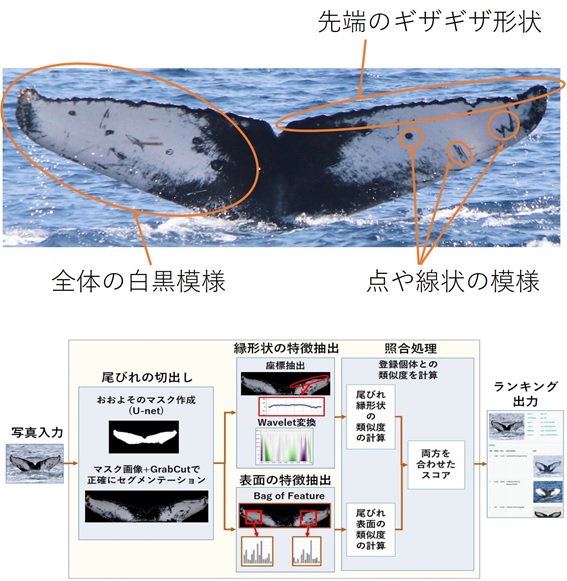
Okinawa Churashima Foundation has collaborated with Diagence, Osaka University and Keio University to optimize the identification process of humpback whale tail fins, and have successfully developed an AI automatic identification system for humpback whales based on their tail fins.
With the development of this system, we can expect a rapid improvement in efficiency compared to manually identifying tail fins. Okinawa Churashima Foundation will utilize this system and work together with domestic and international research institutes with the aim of shedding light on the population structure and the seasonal migration routes of humpback whales in the North Pacific Ocean.
【Authors】Yoshikawa T, Hida M, Lee C, Okabe H, Kobayashi N, Ozawa S, Saito H, Kan M, Date S, Shimojo S (Bold letters: Staff members of Okinawa Churashima Foundation).
【Title】Identification of over one thousand individual wild humpback whales using fluke photos.
【Journal(Conference proceedings)】Proceedings of the 17th International Joint Conference on Computer Vision, Imaging and Computer Graphics Theory and Applications. 4: ISBN 978-989-758-555-5, ISSN 2184-4321, 957-967.
First record of the Japanese blue-spotted seabream off the coast of Okinawa Main Island!

In February 2020, a different sea bream was caught off the coast of Yomitan Village on Okinawa Main Island. A research team, including staff from the Churashima Foundation, determined it was a rare Japanese blue-spotted seabream (Amamiichthys matsubarai), previously only found near Amami Oshima Island.
【Authors】Fukuchi I, Miyamoto K, Tanaka F, Tachihara K (Bold letters: Staff members of Okinawa Churashima Foundation).
【Title】Record of a Japanese blue-spotted seabream (Amamiichthys matsubarai) off the coast of Okinawa Main Island and observation of its reproductive organs.
【Journal】Ichyhy
Publication of scientific paper on reducing aggressive behavior in a pygmy killer whale!
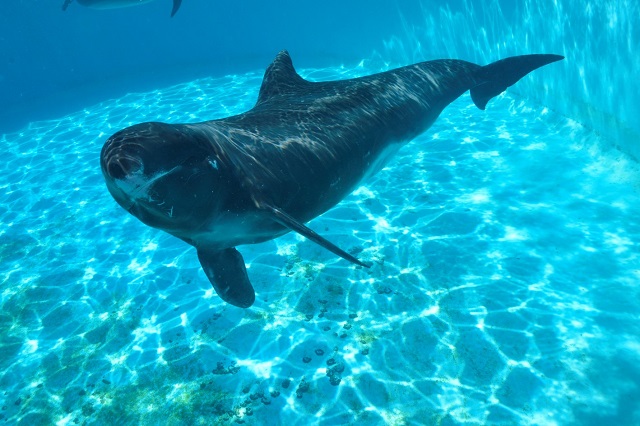
Wild pygmy killer whales are aggressive toward other dolphins, and this is the same in a captive environment. The pygmy killer whale showed frequent aggression toward other dolphins in the tank or the trainers. Social behaviors, such as playing and swimming with others, were also seen less. To encourage more social behavior and reduce aggression, Okinawa Churaumi Aquarium used behavior modification in a similar way to human psychotherapy. This led to an increase in social behavior and significantly reduced aggression. This was done by repeatedly providing a reward of toys, but only when the dolphin showed no signs of aggression.
【Authors】Sayaka Seto, Suguru Higa, Isao Kawazu
【Title】Suppression of aggressive behavior in a captive pygmy killer whale using behavior modification
【Journal】Journal of Japanese Association of Zoos and Aquariums (in Japanese with English abstract)
Paper published on Addition of the Sea Snake, Hydrophis stokesii to the Herpetofauna of Japan
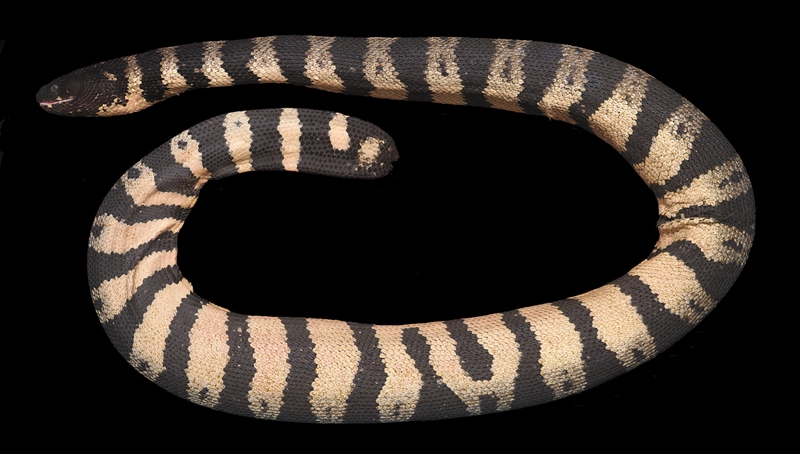
Hydrophis stokesii was collected in the coastal water of Okinawajima Island on 30 March 2021. This is the first record of the species from Japanese waters, extending its known range of occurrence toward east-northeast by more than 900 km from southwest of Taiwan.
【Authors】Takahide Sasai,Takumi Yamamoto, Shinichiro Oka, Mamoru Toda (Bold letters: Staff members of Okinawa Churashima Foundation)
【Title】Addition of the Sea Snake, Hydrophis stokesii (Squamata: E lapidae) to the Herpetofauna of Japan
【Journal】Current Herpetology
Paper published on evaluation of Marine Debris Ingestion in Sea Turtles around Okinawa Island.
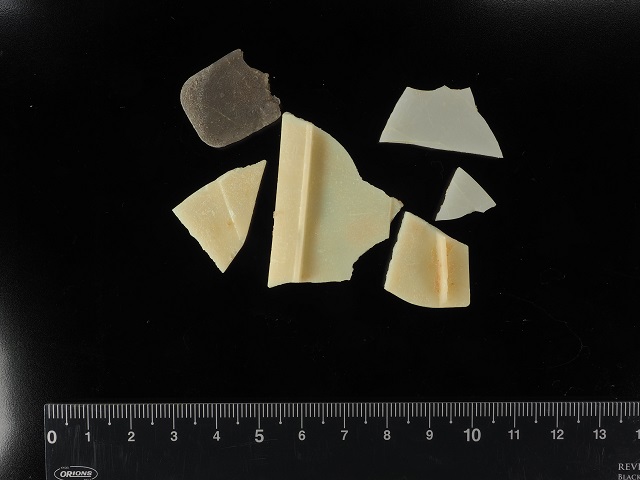
Marine debris is a global problem and has been shown to affect many marine animals. Okinawa Churaumi Aquarium managed by the Okinawa Churaumi Foundation dissected the gastrointestinal tracts of 484 stranded, dead sea turtles from 1990 to 2019 to determine the extent of marine debris ingestion by sea turtles around Okinawa Island, through analysis of frequency and type of marine debris ingested.
【Authors】Takahide Sasai, Masakatsu Kino, Kei Miyamoto, Haruna Okabe, Konomi Maeda, Shingo Fukada,
Ken Maeda, Nozomi Kobayashi, Takahiro Kobuchi, Masae Makabe, Isao Kawazu
【Title】Evaluation of Marine Debris Ingestion in Sea Turtles around Okinawa Island, Japan.
【Journal】Marine Turtle Newsletter
Growth analysis and population size of coconut crabs inhabiting Ocean Expo Park.
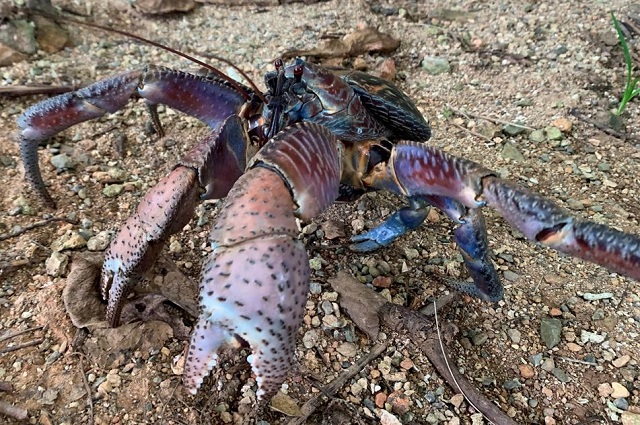
The coconut crab is the largest terrestrial crustacean. It inhabits tropical and subtropical zones of the Indo-Pacific. The global population is decreasing due to overhunting and habitat destruction.
From 2006 to 2019, the Okinawa Churashima Foundation conducted surveys of the coconut crabs that live within Ocean Expo Park. The accumulated data from the 14-year study, including 350 surveys, revealed the rate of growth of coconut crabs and their population size. 506 datasets were obtained from mark-recapture surveys.
【Authors】Shin-ichiro Oka、Koji Tokutake、Tadanobu Inoue (Names in bold : Churashima Foundation Staff)
【Title】Growth analysis and population size estimation of coconut crabs based on a large recapture dataset
【Journal】Crustacean Research (DOI:10.18353/crustacea.50.0_145)
Scientific paper published on the gestation and birth of a pantropical spotted dolphin reared at our facility!
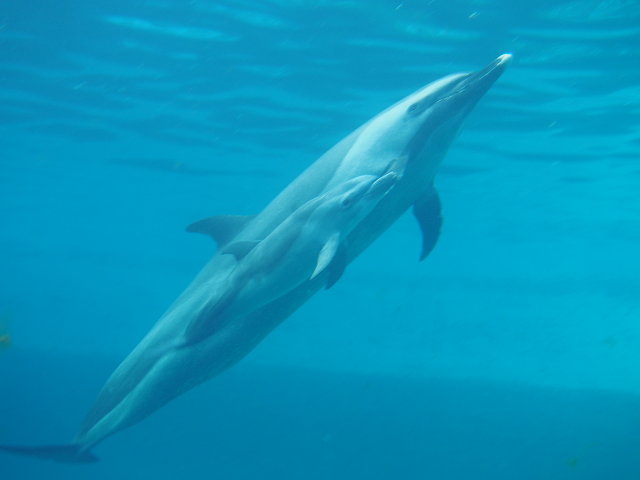
Pantropical spotted dolphins inhabit the tropical and subtropical seas globally, but few have been reared in aquariums. The world’s first successful captive reproduction of a pantropical spotted dolphin took place on March 31st, 2017 at Okinawa Churaumi Aquarium.
From this successful reproduction we knew the length of gestation was 352 days, and we knew how the levels of the female hormone progesterone changed during gestation. It took 9.5 hours for the mother to deliver the baby dolphin, and nursing began 4 hours after birth.
The results from this study can contribute to reproduction programs of pantropical spotted dolphins.
【Authors】Shunya Ikeshima, Suguru Higa, Yuuta Mitani, Mariko Omata, Nozomi Kobayashi, Keiichi Ueda, Isao Kawazu
【Title】First Observation of Pregnancy and Parturition in a Captive Pantropical Spotted Dolphin (Stenella attenuata)
【Journal】Mammal Study
WHALE SHARKS a new book all about whale sharks has been published
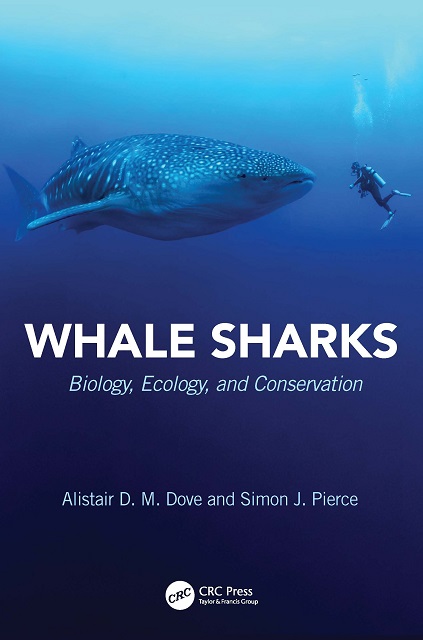
WHALE SHARKS – Biology, Ecology, and Conservation, a new book with the latest research on the ecology and conservation of whale sharks, has been published by CRC Press in America.
In several of the book’s chapters, staff members of Okinawa Churaumi Aquarium (managed and operated by the Okinawa Churaumi Foundation), introduce the results of their research and surveys on whale shark ecology. Whale shark health management at our aquarium, including underwater ultrasound imaging and blood analysis, has resulted in a better understanding of whale shark physiology and reproduction. This new information on whale shark ecology can help with the conservation of this species. The chapters in this book look in-depth at all aspects of whale shark biology including growth, metabolism, migration, ecology, behavior, physiology, and functional anatomy. This book can be read by the public, researchers, conservationists, and resource managers. Okinawa Churaumi Aquarium will continue to rear whale sharks as we conduct research and surveys, while cooperating with research facilities around the world to further shed light on the ecology of whale sharks.
【Chapter Authors】Alistair D.M. Dove, Simon J. Pierce
○Chapter 2:Whale Shark Reproduction, Growth, and Demography.
S.J. Pierce, S.A. Pardo, C.A. Rohner, R. Matsumoto, K. Murakumo, R. Nozu, A.D.M. Dove. (Names in bold : Churashima Foundation Staff)
○Chapter 9:Lessons from Care of Whale Sharks in Public Aquariums.
A.D.M. Dove, R. Matsumoto, C. Schreiber, K. Murakumo, C. Coco, M. Yanagisawa, T. Clauss, L. Hoopes, K. Sato.
(Names in bold : Churashima Foundation Staff)
○Chapter13:Outstanding Questions in Whale Shark Research and Conservation.
Written by all authors (Including Foundation Staff)
【Title】WHALE SHARKS
Biology, Ecology, and Conservation
【Publisher】CRC Press
A third stranding on Okinawa of the rare Longman’s beaked whale!

On the 6th of August 2021, a dead whale was found on the shoreline of Chatan Town in Okinawa Prefecture. The dead whale was examined to determine its appearance and skeletal structure, then based on previous research conducted by the Churashima Foundation (Kobayashi et al. 2021a; 2021b), it was identified as a Longman’s beaked whale. This is a rare whale with only 20 recorded strandings in the world. This individual was a young male approximately 5 meters in length. It is the 5th case of this species stranding in Japan. Previously there had been cases in Hokkaido, Kagoshima, and twice in Okinawa (2011 and 2020).
There is limited knowledge on the habitat of the Longman’s beaked whale, but there have now been several strandings in Okinawa. The Okinawa Churashima Foundation plans to work together with Chatan Town, Japanese and international research facilities to carry out further studies which include analysis of stomach contents and DNA.
Research presentation on the sperm whale stranding at Naha Airport received an award of excellence!
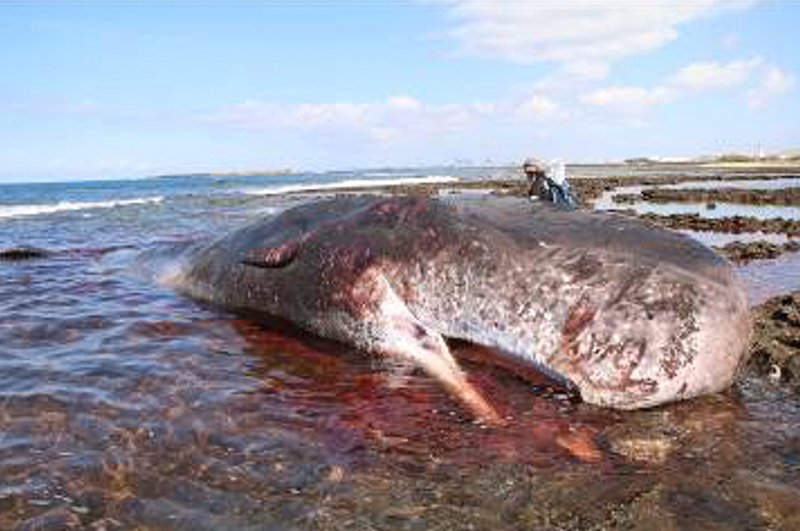
On November 26th, 2020, a dead sperm whale was found on the reef just north of the taxiway at Naha Airport. Sperm whales are widely distributed across the world’s oceans. Males can reach 19 meters in length, and females can reach 12 meters in length.
With the deceased whale, we undertook detailed observations before burying the whale carcass on the airport grounds. Dissection and disposal were difficult, due to operational restrictions at the airport, limiting the use of heavy equipment immediately after the stranding.
Our foundation cooperated with various parties to conduct detailed surveys of decomposition over two months from discovery to burial of the carcass. The results of this research were presented at the Okinawan area Conference of Land, Infrastructure and Transport in 2021. There had been no previous detailed reports on the results of leaving a whale carcass to decay and its burial. This presentation was given the Award for Excellence (Innovation Category). Our foundation will continue to conduct scientific marine research with the goals of conservation of whales and dolphins, and assisting the local community.
Paper published on hawksbill turtles nesting on Okinawa Island
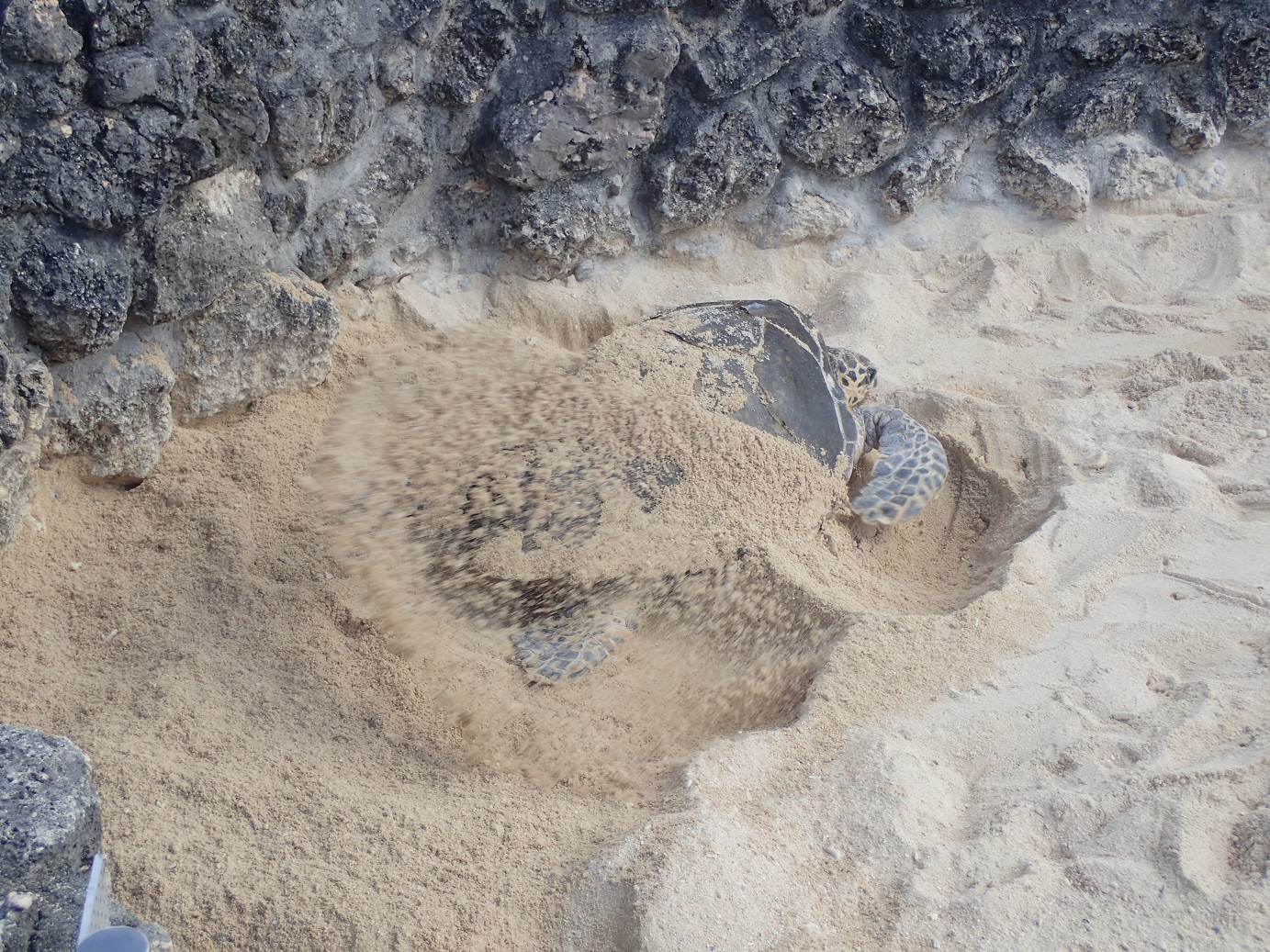
Hawksbill turtles are distributed throughout the world’s temperate and tropical coral reefs.
The global population of hawksbill turtles has drastically decreased due to the loss of nesting grounds and fishing bycatch. It is classified as a Critically Endangered (CR) species on the IUCN Red List (International Union for Conservation of Nature) and is threatened with extinction.
Okinawa Churaumi Aquarium managed by the Okinawa Churaumi Foundation is working together with conservationists on Okinawa Island. Research on sea turtle nesting and reproductive ecology was conducted from 1987 to 2017.
July is the height of the hawksbill turtle nesting season. 28 hawksbill turtle nests were confirmed at 11 Okinawa beaches, including Ogimi Village and Motobu Town.
As the population of hawksbill turtles in Okinawa is small, conservation efforts still need to be strengthened, including regulations on legal capture, and improved protection of the sandy beaches where nesting occurs.
【Authors】Isao Kawazu, Kunio Komesu, Muneyuki Kayou, Takashi Inoue,Masakatsu Kino, Konomi Maeda, Shingo Fukada.(Bold letters: Staff members of Okinawa Churashima Foundation)
【Title】Nesting and reproductive ecology of the hawksbill turtle, Eretmochelys imbricata (Reptilia: Cheloniidae), on Okinawajima Island, Japan
【Journal】The Biological magazine Okinawa
Maintaining neutral buoyancy by sucking in air? A new theory on the mechanism of whale shark feeding
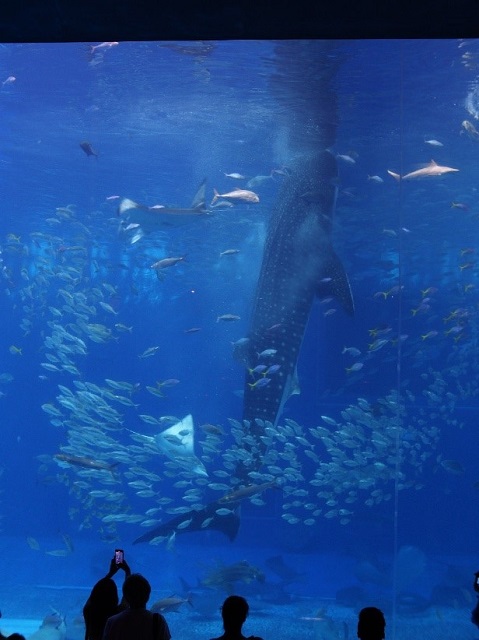
Whale sharks are the world’s largest fish. They can reach over 12 meters in length. Whale sharks mainly eat plankton, and their feeding behavior is complex. One distinctive feature is vertical feeding. When feeding, a whale shark swims vertically with its mouth open so it can suck in plankton floating on the surface.
One mystery about this vertical feeding is that, in general, sharks are denser than water, but whale sharks do not sink during vertical feeding. Whale sharks can even stop moving their tail, but still remain neutrally buoyant while vertical feeding at the surface.
In this research, we estimated the body volume and density of two whale shark reared at the Okinawa Churaumi Aquarium to calculate their weight within the water. Based on the results, we hypothesize that whale sharks suck in air during vertical feeding, and that this extra air in the mouth and gill chamber allow whale sharks to maintain buoyancy. By maintaining buoyancy with sucked air, the whale sharks may save energy during feeding.
【Authors】Taketeru Tomita, Minoru Toda, Kiyomi Murakumo, Kei Miyamoto, Rui Matsumoto,
Keiichi Ueda, Keiichi Sato
【Title】Volume of the whale shark and their mechanism of vertical feeding
【Journal】Zoology
Publication of scientific paper on the movement of humpback whales between Okinawa and the Philippines!
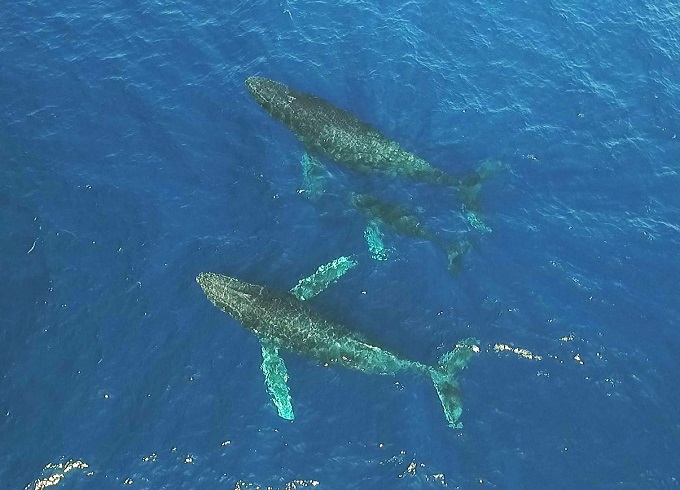
During summer, humpback whales in the North Pacific feed in high latitude regions such as the waters of Russia and Alaska. In winter, they breed, give birth, and raise their young in the waters of Okinawa and the Philippines. Individual humpback whales can be identified by the patterns on their tail fins. The Okinawa Churashima Foundation, in collaboration with a research organization in the Philippines (BALYENA.ORG) conducted surveys and identified individual whales. The results shed light on the interchange of humpback whales between Okinawa and the Philippines, and were published in international journals.
【Authors】Acebes J. M. V, Okabe H, Kobayashi N,Nakagun S, Sakamoto T, Hirney B, Higashi N, Uchida S. (Bold letters: Staff members of Okinawa Churashima Foundation)
【Title】Interchange and movements of humpback whales (Megaptera novaeangliae) between western North Pacific winter breeding grounds in northern Luzon, Philippines and Okinawa, Japan
【Journal】Journal of cetacean research and management
Publication of a scientific paper of Okinawa’s first record of the rare Longman’s beaked whale.
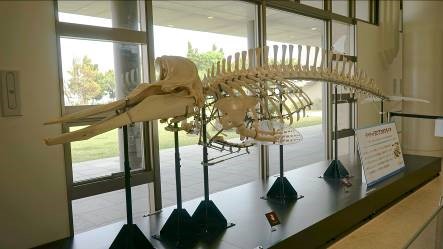
On July 30th, 2011, a rare species of whale was found deceased and stranded on a beach of Ukibaru Island, Uruma City in Okinawa. Research teams from the Okinawa Churashima Foundation and the Japan Fishery Research and Education Agency collaborated to analyze its appearance, bone structure, and DNA (genetic information) and the results showed that the species was a Longman’s beaked whale, which is a very rare type of whale. The individual was a young male 4.8 meters in length. It was the third specimen found in Japan. Previously an individual was found in Kagoshima, and another in Hokkaido. This was the first reported case of this species stranding in Okinawa. The new information about the species was published in an international journal. We recreated the entire skeleton of this individual and it is currently on display in the Churaumi Plaza at the Okinawa Churaumi Aquarium.
【Authors】Nozomi Kobayashi, Koji Tokutake, Hideyoshi Yoshida, Haruna Okabe, Kei Miyamoto, Haruka Ito, Naoto Higashi, Shingo Fukada, Kei Yamazaki, Suguru Higa, Isao Kawazu, Keiichi Ueda (Bold letters: Staff members of Okinawa Churashima Foundation)
【Title】The First Stranding Record of Longman’s Beaked Whale (Indopacetus pacificus) in Okinawa, Japan.
【Journal】Aquatic Mammals
Hard as steel! Understanding the microstructure of a coconut crab’s claw
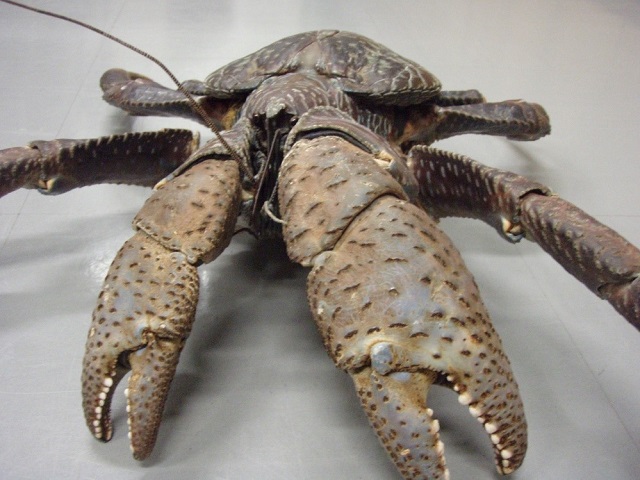
Coconut crabs are the world’s largest terrestrial crustaceans. Their claws can produce a pinching force nearly 100 times the crab’s weight. These extreme forces require the crab to have an exceptionally strong structure. The National Institute for Materials Science and the Okinawa Churashima Foundation collaborated to reveal the microstructures of a coconut crab’s claws using cutting-edge technology.
【Authors】Tadanobu INOUE, Shin-ichiro OKA, Toru HARA
【Title】Three-dimensional microstructure of robust claw of coconut crab, one of the largest terrestrial crustaceans
【Journal】Materials & Design
The genetic traits of the weatherfish Misgurnus sp. OK, an endangered species endemic to Okinawa.

Weatherfish Misgurnus sp. OK is a species endemic to the Ryukyu Islands. In recent years, there has been a sharp decline in its population due to habitat degradation. In 2020, it was designated as one of Okinawa’s endangered species. This prohibits its collection without authorization. Okinawa Churashima Foundation, along with researchers from the University of the Ryukyus, Okinawa Institute of Science and Technology Graduate University (OIST), and Nago Museum, conducted a survey on the genetic diversity of wild populations of this species.
【Authors】Shin-ichiro OKA、Takahide Sasai、Nozomi Hanahara、 Kei Miyamoto、 Hirozumi Kobayashi、Naofumi Murata、Ken Maeda (Bold letters: Staff members of Okinawa Churashima Foundation)
【Title】Genetic traits of the weatherfish Misgurnus sp. OK on the Okinawa Islands, southern Japan
【Journal】Fauna Ryukyuana
Recorded for the first time! Publication of a scientific paper on the discovery of a stranded newborn Longman’s beaked whale (Indopacetus pacificus).
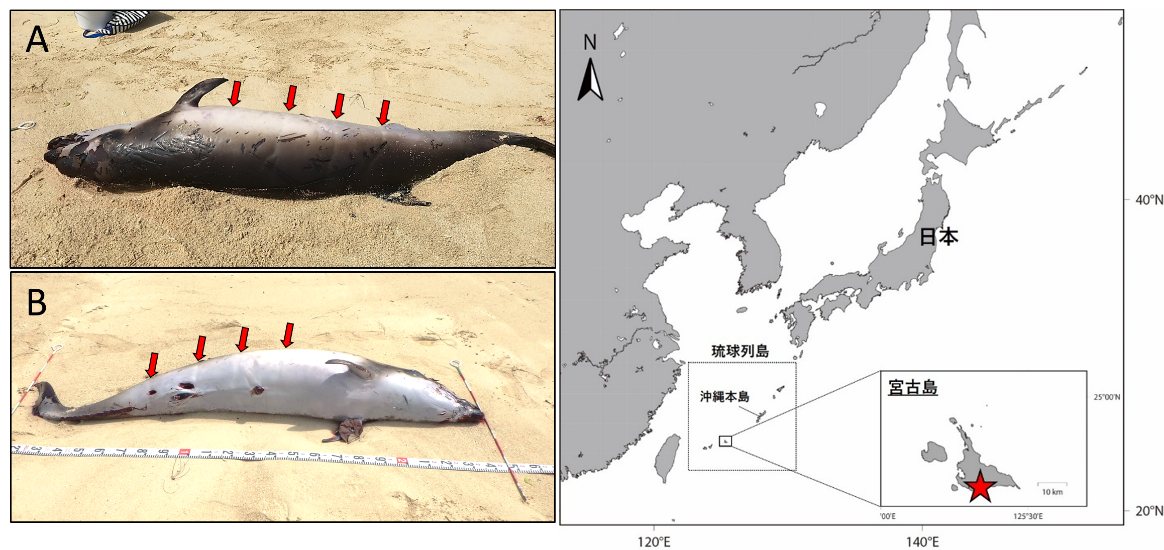
On July 13th, 2020, a deceased newborn Longman’s beaked whale was found stranded on a Miyako Island beach in Okinawa Prefecture. This was reported in the scientific journal Marine Biodiversity Records. The Longman’s beaked whale is an extremely rare species of whale with very few cases observed worldwide. Previous research had estimated its maximum body length at around 6 meters, however, the body length of newborns was not known. The newborn Longman’s beaked whale found stranded on Miyako Island was a female, 2.35 meters in length, with fetal folds on the surface of its body. These fetal folds are only seen for the first few weeks after birth, and are formed on the skin due to the calf being curled in its mother’s womb. Due to the presence of visible fetal folds, it is thought the whale was less than a few weeks old. The discovery of the newborn suggests there is a high possibility of Longman’s beaked whales breeding and giving birth in Okinawan waters. This discovery provides extremely important information to better understand the ecology of this species.
【Authors】Nozomi Kobayashi, Sachie Ozawa, Nozomi Hanahara, Koji Tokutake, Takaaki Kaneshi, Ken Inoue, Haruna Okabe, Kei Miyamoto, Keiichi Ueda (Bold letters: Staff members of Okinawa Churashima Foundation)
【Title of Paper】The first record of a Longman’s beaked whale (Indopacetus pacificus) newborn neonate found on Miyako Island, Okinawa, Japan
【Title of Journal】Marine Biodiversity Records
Publication of scientific paper on genetic identification of goby larvae

Okinawa Churashima Foundation has successfully identified several species of goby using DNA analysis. Gobies are an extremely diverse family of fish made up of over 2000 species. It is extremely difficult to determine the species of a goby larva only by their appearance, and this has restricted research.
In this study, genetic (DNA) analysis was conducted on specimens of goby larvae. We succeeded in identifying 13 species, including 8 species whose larval morphology had not yet been clarified. Furthermore, we showed an easier method to genetically analyze formalin-fixed specimens under certain conditions. This method will contribute further to a better understanding of the ecology of gobies and their larvae.
【Authors】Nozomi Hanahara, Kei Miyamoto, Shin‑ichiro Oka
【Title of Paper】Morphological and genetic identification of formalin‑fixed gobioid larvae and description of postflexion larvae of Paragunnellichthys sp. and Ctenogobiops feroculus
【Title of journal】Ichthyological Research
Publication of scientific paper on the megamouth shark not being a luminous species
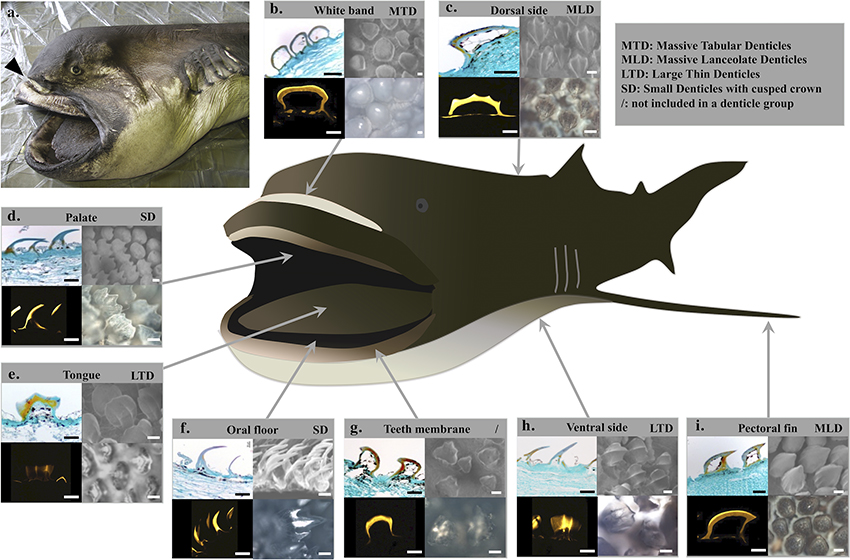
The megamouth shark is a mysterious and rare shark species discovered in the 20th Century. It is known to be a filter feeder, however, the exact feeding mechanism is unclear. One group of researchers had hypothesized that the prominent white band on its upper jaw was a bioluminescent lure. Another group hypothesized that the white band reflected light emitted from bioluminescent prey. Neither theory was proven. This study, conducted in collaboration with a research team from the University of Louvain in Belgium, reexamined the theories on bioluminescence of megamouth sharks.
Researchers used different histological approaches (histological sections, fluorescent in situ hybridization (FISH) and scanning electron microscopy) and spectrophotometry. Researchers determined that the megamouth shark does not have functioning bioluminescent organs. Various forms of tiny placoid scales were found in the white band and in its mouth, which may reflect the bioluminescence produced by its planktonic prey.
Previous theories of the megamouth showing bioluminescence are probably due to the megamouth’s placoid scales reflecting the light from its bioluminescent planktonic prey, or even reflecting scuba diving lights.
【Authors】Laurent Duchatelet, Victoria C. Moris, Taketeru Tomita, Jacques Mahillon, Keiichi Sato, Catherine Behets, Jerome Mallefet(Bold letters: Staff of Okinawa Churaumi Aquari



